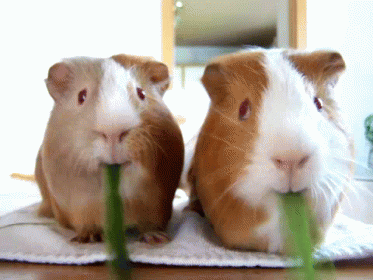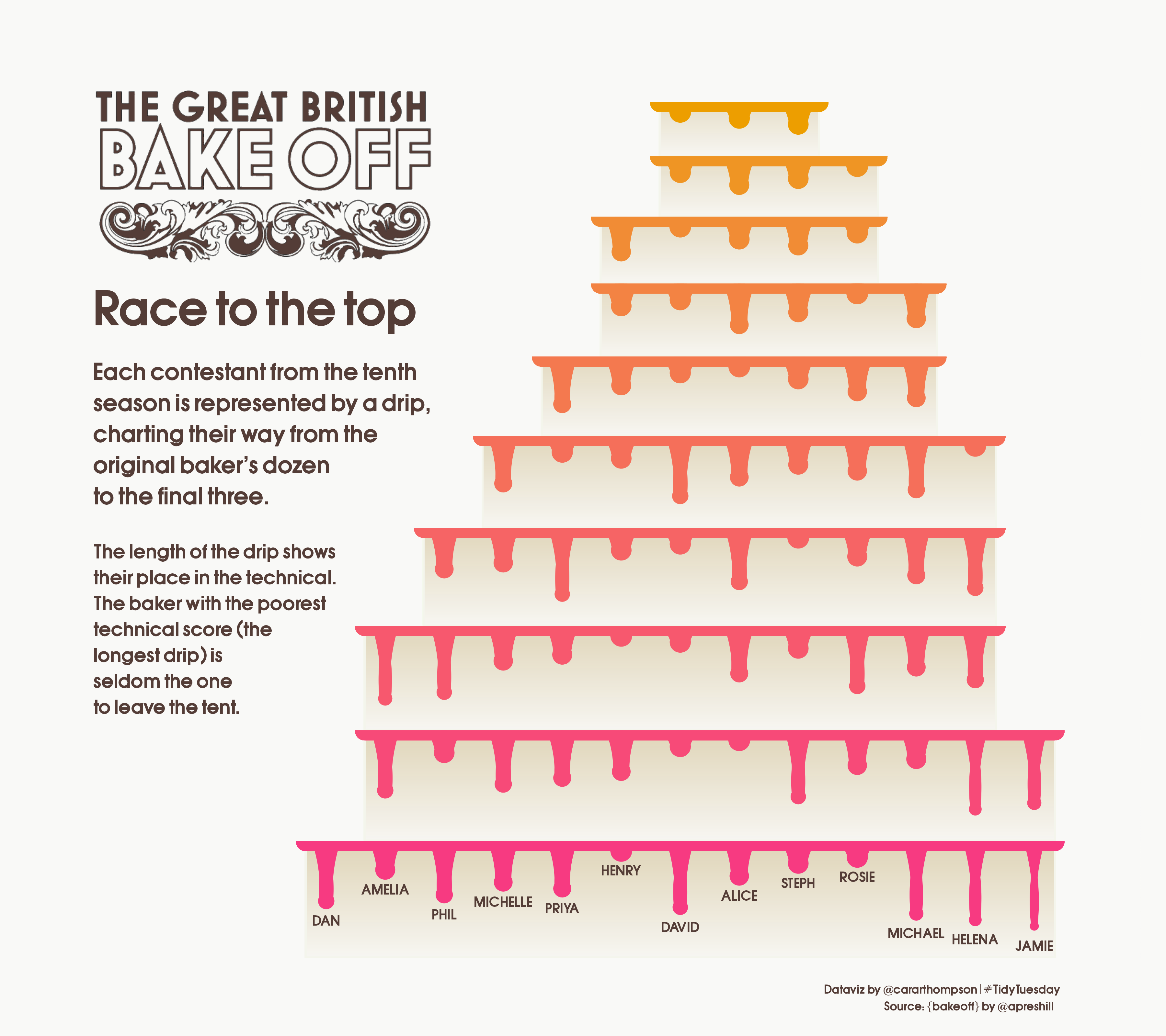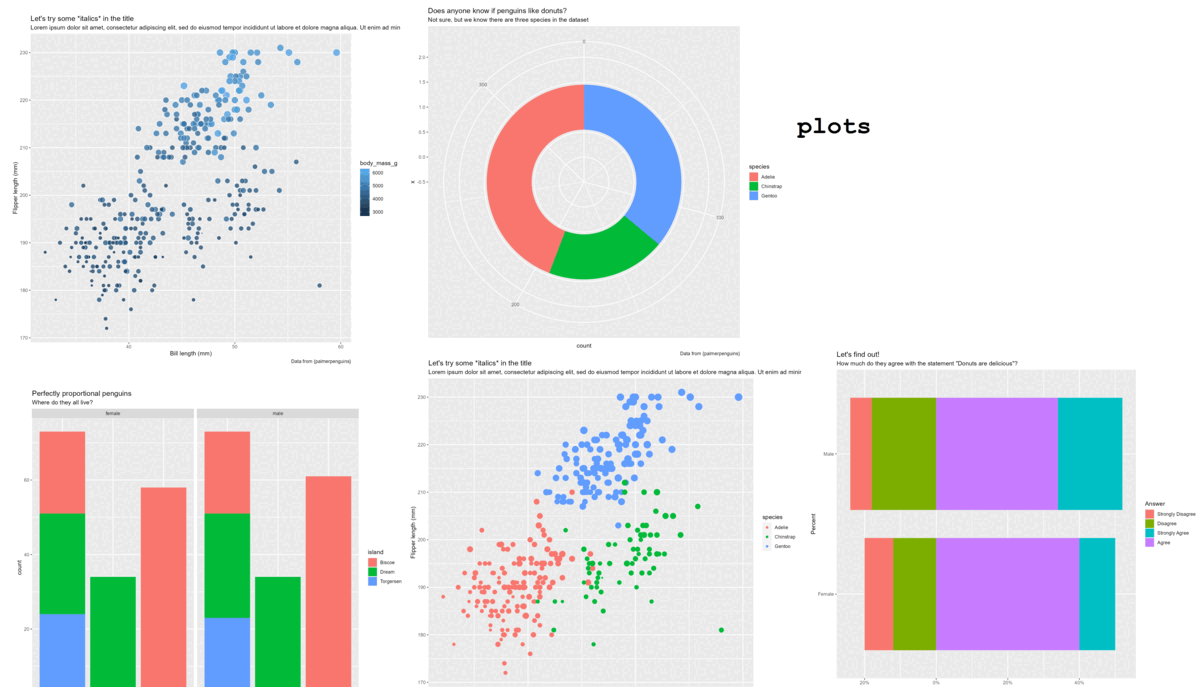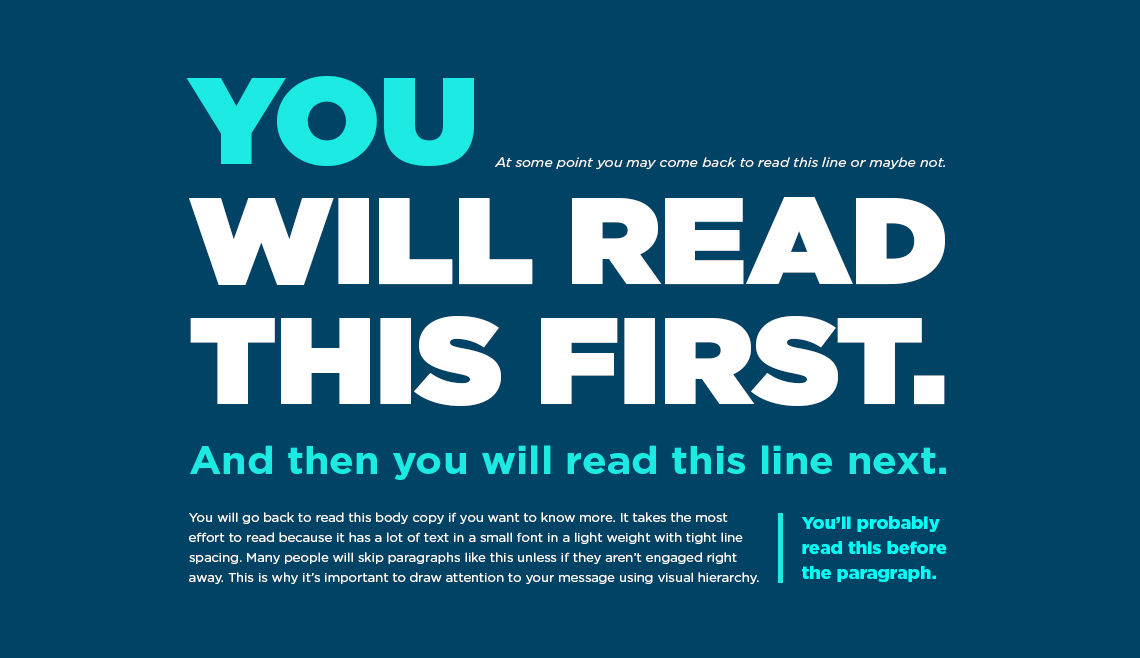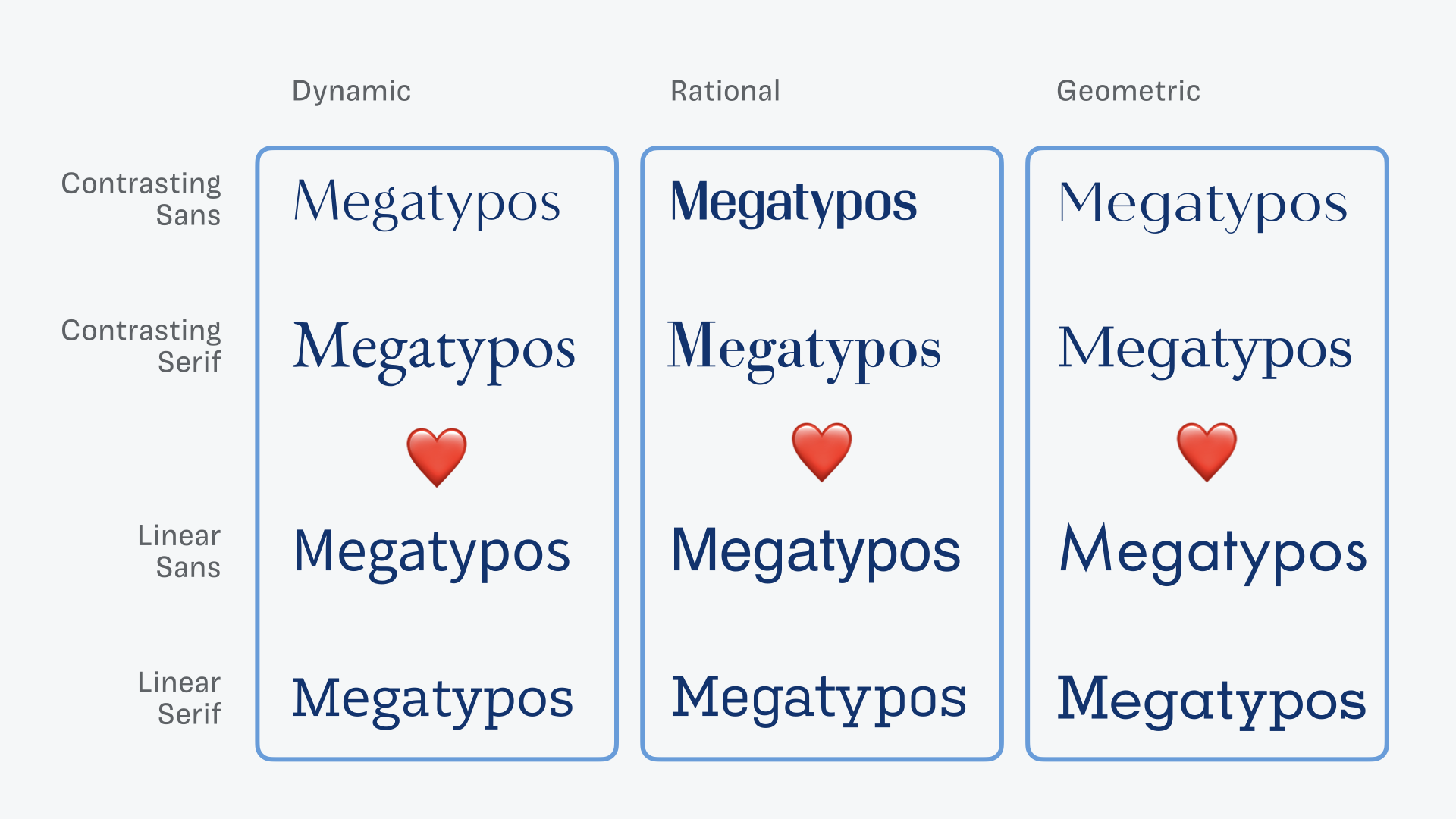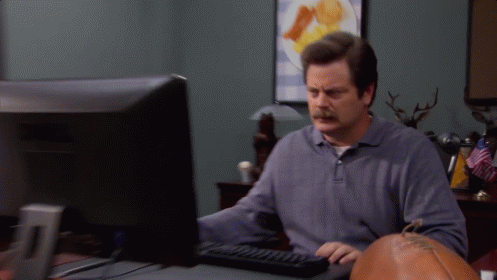Level up your plots
NHS-R Conference 2023 | 4th October 2023
Hi there 👋 !
👩 Cara Thompson
👩💻 Love for patterns in music & language, and a fascination with the human brain |> Psychology PhD |> Analysis of postgraduate medical examinations |> Data Visualisation Consultant
💙 Helping others maximise the impact of their expertise
Find out more: cararthompson.com/about
Today’s goal
To equip you with some design tips and coding tricks to make the most of colour and text to create compelling and memorable visualisations.
- Explore how we can use colour to be less dependent on annotations
- Illustrate ways in which we can use colour and fonts to add text hierarchy
- Apply all of the above to create story-enhancing annotations
- Package up reusable bits of
Rcode - Introduce you to
{ggtext}and{geomtextpath} - Give feedback on your own plots
A bit of housekeeping
- Please ask for help!
- Regular breaks to apply what we’re learning to your own plots
- if you get stuck / want to share something for feedback:
hello@cararthompson.com
- if you get stuck / want to share something for feedback:
- Namespacing (
package::function("blah")) - Choose your own pipe
- Reuse as much of the code as you like!
“Intuitive colour palettes?”
Find out more: en.wikipedia.org/wiki/Bouba/kiki_effect
“Intuitive colour palettes?”
Let’s play a quick game…
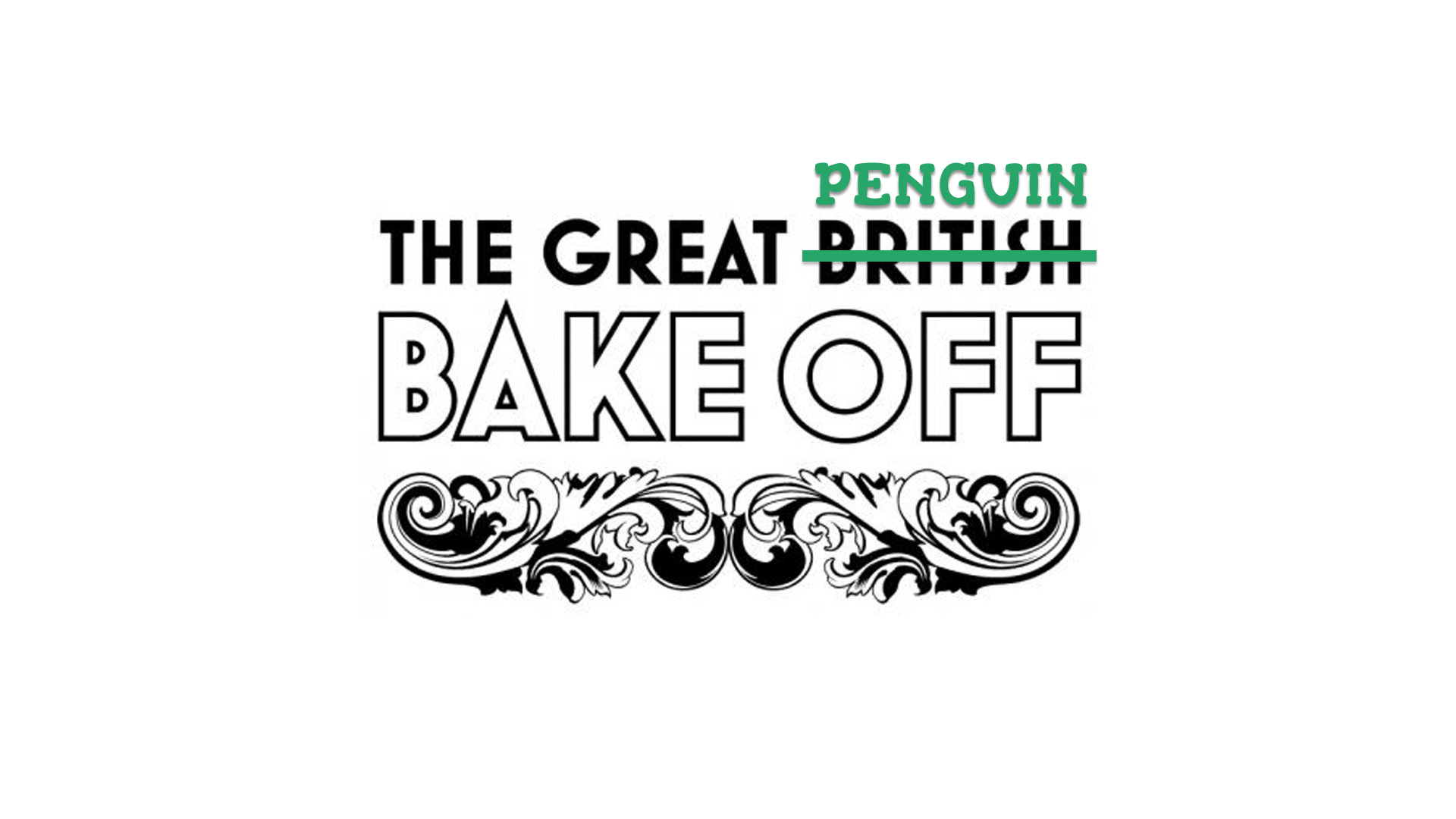
The Great Penguin Bake Off
The penguins had a baking competition to see which species could make the best banana loaf. Each species was given bananas of a different level of ripeness.

The Great Penguin Bake Off
The penguins had a baking competition to see which species could make the best banana loaf. Each species was given bananas of a different level of ripeness.

The Great Penguin Bake Off
The Adelie penguins decided to experiment with different quantities of banana in their mix. Each island chose a different quantity.

The Great Penguin Bake Off
The Adelie penguins decided to experiment with different quantities of unripe banana in their mix. Each island chose a different quantity.

The Great Penguin Bake Off
They decided to go on a retreat to plan their bakes in different locations

The Great Penguin Bake Off
Each species was allowed to invite a different mentor…

The Great Penguin Bake Off
… and to choose a type of snack between practice bakes

The Great Penguin Bake Off - Bonus round!
The penguins also baked their cakes for different amounts of time. Here are the mean durations per species.

The Great Penguin Bake Off - Bonus round!
The penguins also baked their cakes for different amounts of time. Here are the mean durations per species.


Compelling and memorable visualisations
#1 - Use colour and orientation purposefully
#2 - Add text hierarchy
#3 - Reduce unnecessary eye movement
#4 - Highlight important patterns
Let’s get coding!
Setting up our first plot
Setting up our first plot
With a few tips along the way
Setting up our first plot
With a few tips along the way
Setting up our first plot
With a few tips along the way
Setting up our first plot
Mini tip: get rid of abbreviations
ToothGrowth %>%
mutate(supplement =
case_when(supp == "OJ" ~ "Orange Juice",
supp == "VC" ~ "Vitamin C",
TRUE ~ as.character(supp))) %>%
group_by(supplement, dose) %>%
summarise(mean_length = mean(len)) %>%
ggplot(aes(x = dose,
y = mean_length,
fill = supplement)) +
geom_bar(stat = "identity",
position = "dodge",
colour = "#FFFFFF",
size = 2)Setting up our first plot
Mini tip: theme_minimal()
ToothGrowth %>%
mutate(supplement =
case_when(supp == "OJ" ~ "Orange Juice", supp == "VC" ~ "Vitamin C", TRUE ~ as.character(supp))) %>%
group_by(supplement, dose) %>%
summarise(mean_length = mean(len)) %>%
ggplot(aes(x = dose,
y = mean_length,
fill = supplement)) +
geom_bar(stat = "identity",
position = "dodge",
colour = "#FFFFFF",
size = 2) +
theme_minimal()Setting up our first plot
Turning Dose into a categorical variable (fear not!)
ToothGrowth %>%
mutate(supplement = case_when(supp == "OJ" ~ "Orange Juice", supp == "VC" ~ "Vitamin C", TRUE ~ as.character(supp))) %>%
group_by(supplement, dose) %>%
summarise(mean_length = mean(len)) %>%
mutate(categorical_dose = factor(dose)) %>%
ggplot(aes(x = categorical_dose,
y = mean_length,
fill = supplement)) +
geom_bar(stat = "identity",
position = "dodge",
colour = "#FFFFFF",
size = 2) +
theme_minimal()Setting up our first plot
Turning Dose into a categorical variable (fear not!) + facetting
ToothGrowth %>%
mutate(supplement = case_when(supp == "OJ" ~ "Orange Juice", supp == "VC" ~ "Vitamin C", TRUE ~ as.character(supp))) %>%
group_by(supplement, dose) %>%
summarise(mean_length = mean(len)) %>%
mutate(categorical_dose = factor(dose)) %>%
ggplot(aes(x = categorical_dose,
y = mean_length,
fill = supplement)) +
geom_bar(stat = "identity",
colour = "#FFFFFF",
size = 2) +
facet_wrap(supplement ~ ., ncol = 1) +
theme_minimal()Setting up our first plot
Adding some text (finally!)
ToothGrowth %>%
mutate(supplement = case_when(supp == "OJ" ~ "Orange Juice", supp == "VC" ~ "Vitamin C", TRUE ~ as.character(supp))) %>%
group_by(supplement, dose) %>%
summarise(mean_length = mean(len)) %>%
mutate(categorical_dose = factor(dose)) %>%
ggplot(aes(x = categorical_dose,
y = mean_length,
fill = supplement)) +
geom_bar(stat = "identity",
colour = "#FFFFFF",
size = 2) +
labs(x = "Dose",
y = "Mean length (mm)",
title = "In smaller doses, Orange Juice was associated with greater mean tooth growth,
compared to equivalent doses of Vitamin C",
subtitle = "With the highest dose, the mean recorded length was almost identical.") +
facet_wrap(supplement ~ ., ncol = 1) +
theme_minimal()Setting up our first plot
Legend + facet strip + colour + title… Wait, which one is which?
#1 - Use colour purposefully
- Orange juice is… orange!
- Vitamin C is… also orange, but more red and “aggressive”
- Those green leaves look nice with those colours…
- imagecolorpicker.com
#1 - Use colour purposefully
Generating a colour palette, starting with orange juice! #fab909
[1] "#DB5A05" "#E93603" "#F71201"[1] "#3C6B30" "#0C1509"[1] "#0C1509" "#323A30" "#595F57" "#80857F" "#A7AAA6" "#CED0CD"#1 - Use colour purposefully
Creating a named vector

#1 - Use colour purposefully
Back to the plot!
ToothGrowth %>%
mutate(supplement = case_when(supp == "OJ" ~ "Orange Juice", supp == "VC" ~ "Vitamin C", TRUE ~ as.character(supp))) %>%
group_by(supplement, dose) %>%
summarise(mean_length = mean(len)) %>%
mutate(categorical_dose = factor(dose)) %>%
ggplot(aes(x = categorical_dose,
y = mean_length,
fill = supplement)) +
geom_bar(stat = "identity",
colour = "#FFFFFF",
size = 2) +
labs(x = "Dose",
y = "Mean length (mm)",
title = "In smaller doses, Orange Juice was associated with greater mean tooth growth,
compared to equivalent doses of Vitamin C",
subtitle = "With the highest dose, the mean recorded length was almost identical.") +
facet_wrap(supplement ~ ., ncol = 1) +
theme_minimal()#1 - Use colour purposefully
Add in our colours
ToothGrowth %>%
mutate(supplement = case_when(supp == "OJ" ~ "Orange Juice", supp == "VC" ~ "Vitamin C", TRUE ~ as.character(supp))) %>%
group_by(supplement, dose) %>%
summarise(mean_length = mean(len)) %>%
mutate(categorical_dose = factor(dose)) %>%
ggplot(aes(x = categorical_dose,
y = mean_length,
fill = supplement)) +
geom_bar(stat = "identity",
colour = "#FFFFFF",
size = 2) +
labs(x = "Dose",
y = "Mean length (mm)",
title = "In smaller doses, Orange Juice was associated with greater mean tooth growth,
compared to equivalent doses of Vitamin C",
subtitle = "With the highest dose, the mean recorded length was almost identical.") +
scale_fill_manual(values = c("#fab909",
"#E93603")) +
facet_wrap(supplement ~ ., ncol = 1) +
theme_minimal()#1 - Use colour purposefully
Add in our colours - wait, what?
ToothGrowth %>%
mutate(supplement = case_when(supp == "OJ" ~ "Orange Juice", supp == "VC" ~ "Vitamin C", TRUE ~ as.character(supp))) %>%
group_by(supplement, dose) %>%
summarise(mean_length = mean(len)) %>%
mutate(categorical_dose = factor(dose),
supplement =
factor(supplement,
levels = c("Vitamin C",
"Orange Juice"))) %>%
ggplot(aes(x = categorical_dose,
y = mean_length,
fill = supplement)) +
geom_bar(stat = "identity",
colour = "#FFFFFF",
size = 2) +
labs(x = "Dose",
y = "Mean length (mm)",
title = "In smaller doses, Orange Juice was associated with greater mean tooth growth,
compared to equivalent doses of Vitamin C",
subtitle = "With the highest dose, the mean recorded length was almost identical.") +
scale_fill_manual(values = c("#fab909",
"#E93603")) +
facet_wrap(supplement ~ ., ncol = 1) +
theme_minimal()#1 - Use colour purposefully
Add in our colours - named vector to the rescue!
ToothGrowth %>%
mutate(supplement = case_when(supp == "OJ" ~ "Orange Juice", supp == "VC" ~ "Vitamin C", TRUE ~ as.character(supp))) %>%
group_by(supplement, dose) %>%
summarise(mean_length = mean(len)) %>%
mutate(categorical_dose = factor(dose),
supplement =
factor(supplement,
levels = c("Vitamin C",
"Orange Juice"))) %>%
ggplot(aes(x = categorical_dose,
y = mean_length,
fill = supplement)) +
geom_bar(stat = "identity",
colour = "#FFFFFF",
size = 2) +
labs(x = "Dose",
y = "Mean length (mm)",
title = "In smaller doses, Orange Juice was associated with greater mean tooth growth,
compared to equivalent doses of Vitamin C",
subtitle = "With the highest dose, the mean recorded length was almost identical.") +
scale_fill_manual(values = vit_c_palette) +
facet_wrap(supplement ~ ., ncol = 1) +
theme_minimal()#1 - Use colour purposefully
Add in our colours - named vector to the rescue!
Key advantages
- Know the colours are applied to the right data points!
- Keep colour-data pairings consistent throughout the project
- Package up a default palette
- Easily reuse colours in the text
ggtext::element_markdown()later in this workshop
#1 - Use colour purposefully
Get rid of unused colours
ToothGrowth %>%
mutate(supplement = case_when(supp == "OJ" ~ "Orange Juice", supp == "VC" ~ "Vitamin C", TRUE ~ as.character(supp))) %>%
group_by(supplement, dose) %>%
summarise(mean_length = mean(len)) %>%
mutate(categorical_dose = factor(dose)) %>%
ggplot(aes(x = categorical_dose,
y = mean_length,
fill = supplement)) +
geom_bar(stat = "identity",
colour = "#FFFFFF",
size = 2) +
labs(x = "Dose",
y = "Mean length (mm)",
title = "In smaller doses, Orange Juice was associated with greater mean tooth growth,
compared to equivalent doses of Vitamin C",
subtitle = "With the highest dose, the mean recorded length was almost identical.") +
scale_fill_manual(values = vit_c_palette) +
facet_wrap(supplement ~ ., ncol = 1) +
theme_minimal()#1 - Use colour purposefully
Get rid of unused colours
ToothGrowth %>%
mutate(supplement = case_when(supp == "OJ" ~ "Orange Juice", supp == "VC" ~ "Vitamin C", TRUE ~ as.character(supp))) %>%
group_by(supplement, dose) %>%
summarise(mean_length = mean(len)) %>%
mutate(categorical_dose = factor(dose)) %>%
ggplot(aes(x = categorical_dose,
y = mean_length,
fill = supplement)) +
geom_bar(stat = "identity",
colour = "#FFFFFF",
size = 2) +
labs(x = "Dose",
y = "Mean length (mm)",
title = "In smaller doses, Orange Juice was associated with greater mean tooth growth,
compared to equivalent doses of Vitamin C",
subtitle = "With the highest dose, the mean recorded length was almost identical.") +
scale_fill_manual(values = vit_c_palette,
limits = force) +
facet_wrap(supplement ~ ., ncol = 1) +
theme_minimal()#1 - Use colour purposefully
Use transparency to indicate dose
ToothGrowth %>%
mutate(supplement = case_when(supp == "OJ" ~ "Orange Juice", supp == "VC" ~ "Vitamin C", TRUE ~ as.character(supp))) %>%
group_by(supplement, dose) %>%
summarise(mean_length = mean(len)) %>%
mutate(categorical_dose = factor(dose)) %>%
ggplot(aes(x = categorical_dose,
y = mean_length,
fill = supplement)) +
geom_bar(aes(alpha = dose),
stat = "identity",
colour = "#FFFFFF",
size = 2) +
labs(x = "Dose",
y = "Mean length (mm)",
title = "In smaller doses, Orange Juice was associated with greater mean tooth growth,
compared to equivalent doses of Vitamin C",
subtitle = "With the highest dose, the mean recorded length was almost identical.") +
scale_fill_manual(values = vit_c_palette, limits = force) +
facet_wrap(supplement ~ ., ncol = 1) +
theme_minimal()#1 - Use colour purposefully
Use transparency to indicate dose - within limits
ToothGrowth %>%
mutate(supplement = case_when(supp == "OJ" ~ "Orange Juice", supp == "VC" ~ "Vitamin C", TRUE ~ as.character(supp))) %>%
group_by(supplement, dose) %>%
summarise(mean_length = mean(len)) %>%
mutate(categorical_dose = factor(dose)) %>%
ggplot(aes(x = categorical_dose,
y = mean_length,
fill = supplement)) +
geom_bar(aes(alpha = dose),
stat = "identity",
colour = "#FFFFFF",
size = 2) +
labs(x = "Dose",
y = "Mean length (mm)",
title = "In smaller doses, Orange Juice was associated with greater mean tooth growth,
compared to equivalent doses of Vitamin C",
subtitle = "With the highest dose, the mean recorded length was almost identical.") +
scale_fill_manual(values = vit_c_palette, limits = force) +
scale_alpha(range = c(0.33, 1)) +
facet_wrap(supplement ~ ., ncol = 1) +
theme_minimal()#1 - Use colour purposefully
What is the dose unit again? ?ToothGrowth
ToothGrowth %>%
mutate(supplement = case_when(supp == "OJ" ~ "Orange Juice", supp == "VC" ~ "Vitamin C", TRUE ~ as.character(supp))) %>%
group_by(supplement, dose) %>%
summarise(mean_length = mean(len)) %>%
mutate(categorical_dose = factor(dose)) %>%
ggplot(aes(x = categorical_dose,
y = mean_length,
fill = supplement)) +
geom_bar(aes(alpha = dose),
stat = "identity",
colour = "#FFFFFF",
size = 2) +
labs(x = "Dose",
y = "Mean length (mm)",
title = "In smaller doses, Orange Juice was associated with greater mean tooth growth,
compared to equivalent doses of Vitamin C",
subtitle = "With the highest dose, the mean recorded length was almost identical.") +
scale_fill_manual(values = vit_c_palette, limits = force) +
scale_alpha(range = c(0.33, 1)) +
scale_x_discrete(breaks = c("0.5", "1", "2"),
labels = function(x)
paste0(x, " mg/day")) +
facet_wrap(supplement ~ ., ncol = 1) +
theme_minimal()#1 - Use colour purposefully
Legend has always been redundant!
ToothGrowth %>%
mutate(supplement = case_when(supp == "OJ" ~ "Orange Juice", supp == "VC" ~ "Vitamin C", TRUE ~ as.character(supp))) %>%
group_by(supplement, dose) %>%
summarise(mean_length = mean(len)) %>%
mutate(categorical_dose = factor(dose)) %>%
ggplot(aes(x = categorical_dose,
y = mean_length,
fill = supplement)) +
geom_bar(aes(alpha = dose),
stat = "identity",
colour = "#FFFFFF",
size = 2) +
labs(x = "Dose",
y = "Mean length (mm)",
title = "In smaller doses, Orange Juice was associated with greater mean tooth growth,
compared to equivalent doses of Vitamin C",
subtitle = "With the highest dose, the mean recorded length was almost identical.") +
scale_fill_manual(values = vit_c_palette, limits = force) +
scale_alpha(range = c(0.33, 1)) +
facet_wrap(supplement ~ ., ncol = 1) +
scale_x_discrete(breaks = c("0.5", "1", "2"), labels = function(x) paste0(x, " mg/day")) +
theme_minimal() +
theme(legend.position = "none")#1 - Use colour purposefully
And I find this so much less confusing!
ToothGrowth %>%
mutate(supplement = case_when(supp == "OJ" ~ "Orange Juice", supp == "VC" ~ "Vitamin C", TRUE ~ as.character(supp))) %>%
group_by(supplement, dose) %>%
summarise(mean_length = mean(len)) %>%
mutate(categorical_dose = factor(dose)) %>%
ggplot(aes(x = categorical_dose,
y = mean_length,
fill = supplement)) +
geom_bar(aes(alpha = dose),
stat = "identity",
colour = "#FFFFFF",
size = 2) +
labs(x = "Dose",
y = "Mean length (mm)",
title = "In smaller doses, Orange Juice was associated with greater mean tooth growth,
compared to equivalent doses of Vitamin C",
subtitle = "With the highest dose, the mean recorded length was almost identical.") +
scale_fill_manual(values = vit_c_palette, limits = force) +
scale_alpha(range = c(0.4, 1)) +
scale_x_discrete(breaks = c("0.5", "1", "2"), labels = function(x) paste0(x, " mg/day")) +
coord_flip() +
facet_wrap(supplement ~ ., ncol = 1) +
theme_minimal() +
theme(legend.position = "none")#1 - Use colour (and orientation) purposefully
So much clearer, and we haven’t even done any annotating!
#1 Over to you - but first…
It’s all about making it easier to remember what is what
Picking colours is hard! Let others help you!
- Your brand guidelines
- A photo + something like imagecolorpicker.com to pick out colours
#1 Use colour purposefully

#1 Use colour purposefully
#1 Use colour purposefully
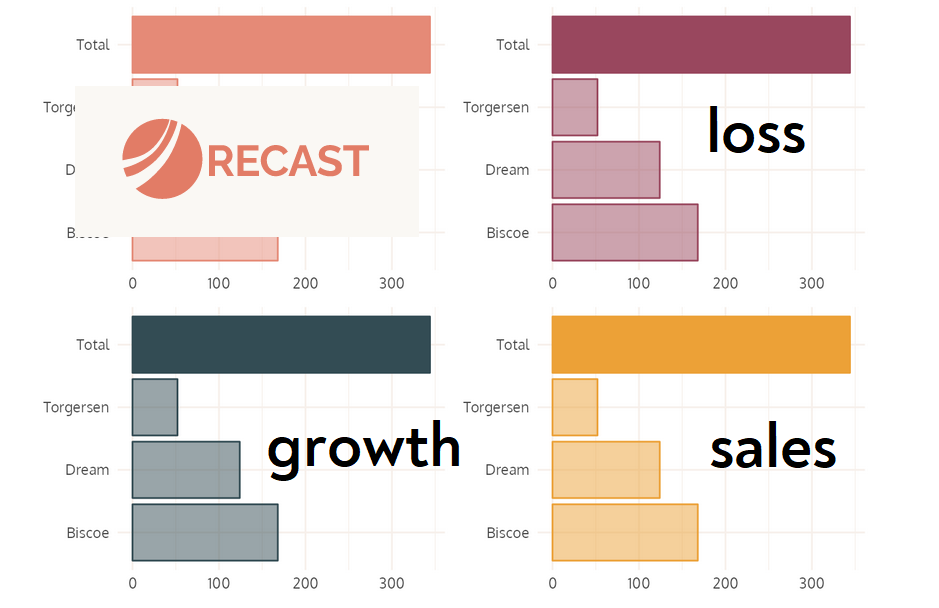
#1 Use colour purposefully


#1 Use colour purposefully
- Your department brand guidelines
- A photo + something like imagecolorpicker.com to pick out colours
- Take inspiration from photos/ other dataviz / art you like
#1 Use colour purposefully
#1 Use colour purposefully
#1 Use colour purposefully
- Your department brand guidelines
- A photo + something like imagecolorpicker.com to pick out colours
- Take inspiration from other dataviz / art you like
- Google images and “[whatever you like] palette”
#1 Use colour purposefully
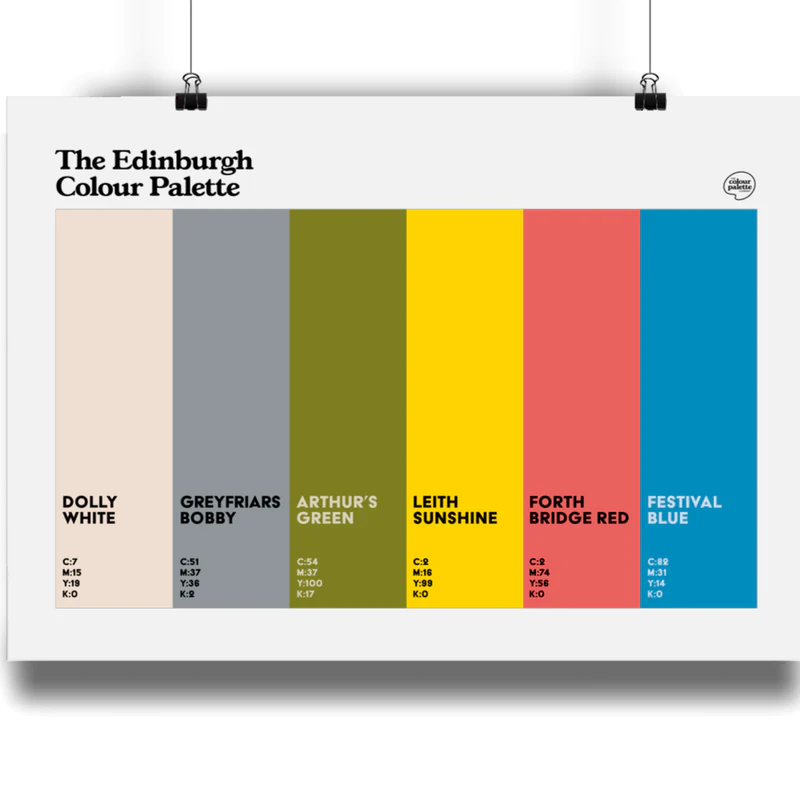
Source: The Colour Palette Company
#1 Use colour purposefully
- Your department brand guidelines
- A photo + something like imagecolorpicker.com to pick out colours
- Take inspiration from other dataviz / art you like
- Google images and “[whatever you like] palette”
- Or… start from the colour wheel and read around how best to use it
- Using a tool like paletton.com makes it easier!
Find out more: blog.datawrapper.de/colors-for-data-vis-style-guides/
#1 Use colour purposefully
Quick tip: Viewing your colours
#1 Use colour purposefully
Quick tip: Naming and viewing your colours
Manipulating colours - Terminology
- Hue: “what colour”?
- Saturation: “how colourful?”
- Value: “how light?”
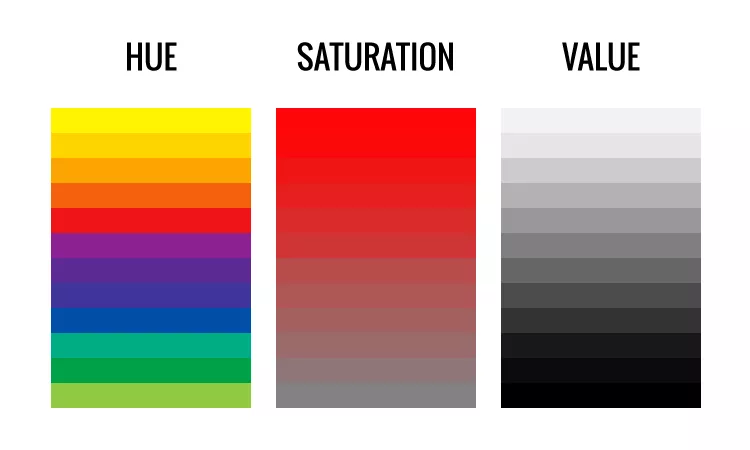
Manipulating colours | Amounts
Back to the bake-off… Value / transparency (blank background!)

Manipulating colours | Cumulative effect
Transparency with outlines
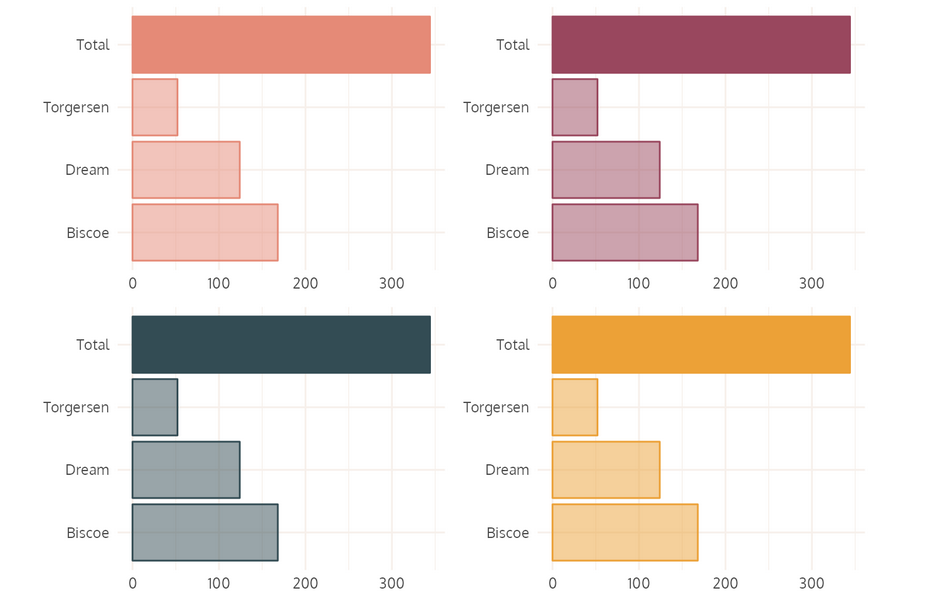
Manipulating colours | Recency
Which line shows the most recent data?

Manipulating colours | Recency

Manipulating colours | Recency
Playing with value (a “lighter” green)

Manipulating colours | Recency
Playing with saturation (a “less green” green)

Manipulating colours | Recency (“Going grey”)
Combining the two

Manipulating colours | Recency (“Going grey”)
[1] "#3D6946" "#597C60" "#76907B" "#92A496" "#AFB8B1"
Now also a shiny app! cararthompson.shinyapps.io/monochromeR
#1 Use colour purposefully
Final colour hack: Test it out with text and background
#1 Use colour purposefully
Final colour hack: Test it out with text and background


#1 Use colour purposefully
Final colour hack: Test it out with text and background



{monochromeR} can help!
Over to you!
- Think about the concepts in your own data
- Look for images related to those concepts
- Extract the colour codes you need -
imagecolorpicker.com - Name them & check what they look like together -
monochromeR::view_palette()
You have 10 minutes! 📊 🎨 ☕
10:00
#1 Use colour purposefully
A few extra things to bear in mind
- Accessibility
colorblindr::cvd_grid()remotes::install_github("clauswilke/colorblindr")
https://github.com/clauswilke/colorblindr
#1 Use colour purposefully
A few things to bear in mind
- Accessibility
colorblindr::cvd_grid()- colourcontrast.cc
#1 Use colour purposefully
A few things to bear in mind
- Accessibility
- Race/Ethnicity - avoid stereotypes and be mindful of unintended messages
- Colour intensity - “more is more”
More than green and red!
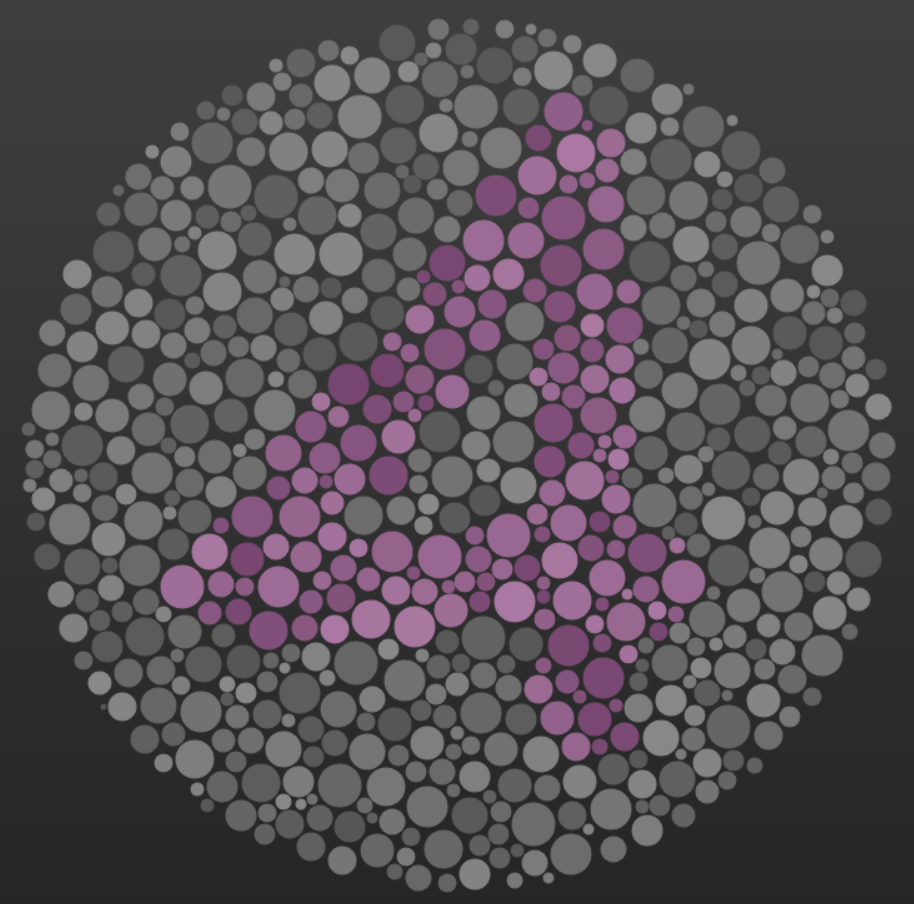
https://enchroma.com/pages/color-blindness-test
More than green and red!
- Colour perception differences
- Green / Red / Blue / Combinations
- Neurodivergent audiences - 10-15% of global population
- Behavioural / emotional disorders
- ADHD
- Learning disabilities
- Autism
Source: Nightingale magazine - Issue 03
The case for designing with accessibility first
- It makes it better for everyone
- Less visually overwhelming (colour minimalism)
- Easier to read (text & fonts next time!)
- Make the main thing the main thing (visual hierarchy)
- It makes it more environment-proof
- Poor quality screenshot / zoom pixelation
- Printing in black and white
- Projector quality for slides at conferences / demos
Source: Nightingale magazine - Issue 03
The case for designing with accessibility first
- Colour
- Shades of the same colour rather than lots of different colours
- Prefer muted colours over stark contrasts
- Typography (readability)
- Visual hierarchy (where next?)
- Patterns (predictable repetition)
Source: Nightingale magazine - Issue 03
Distinguishable colours
“Web Content Accessibility Guidelines (WACG) 2.1 standards call for a contrast ratio of at least 3:1 for ‘meaningful graphics’. Achieving this is a mathematical impossibility for any palette containing just a small handful of colours, let alone one as a comprehensive as a data design system requires.”
- Ben Willers, Power of Colour: Creating a new data design system for Economist Impact (Nightingale magazine, Issue 03, p 88)
So we do the best we can to make sure colours, chosen with additional accessibility criteria in mind, are visibly distinct from each other for a range of audiences.
Distinguishable colours
R: {monochromeR} + {colorblindr}
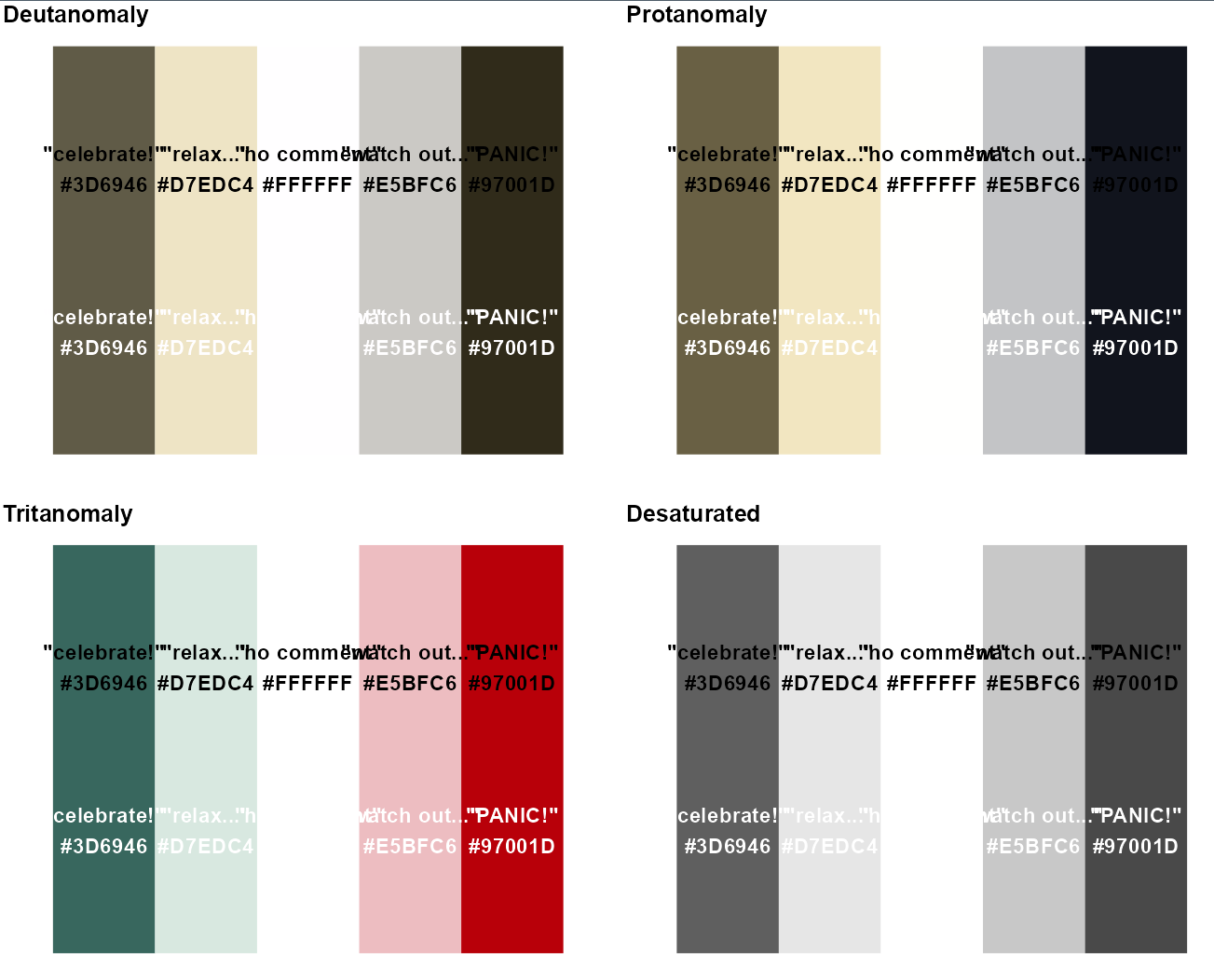
Distinguishable colours
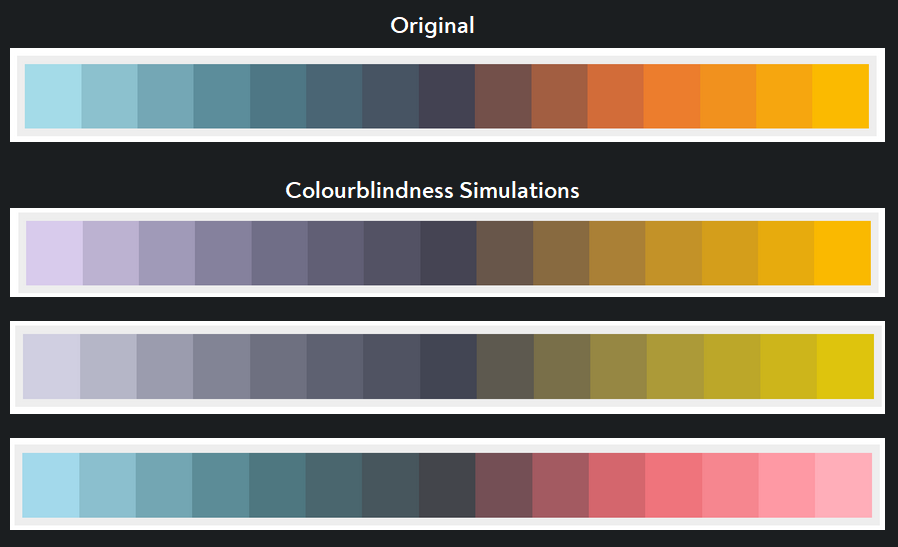
Distinguishable colours
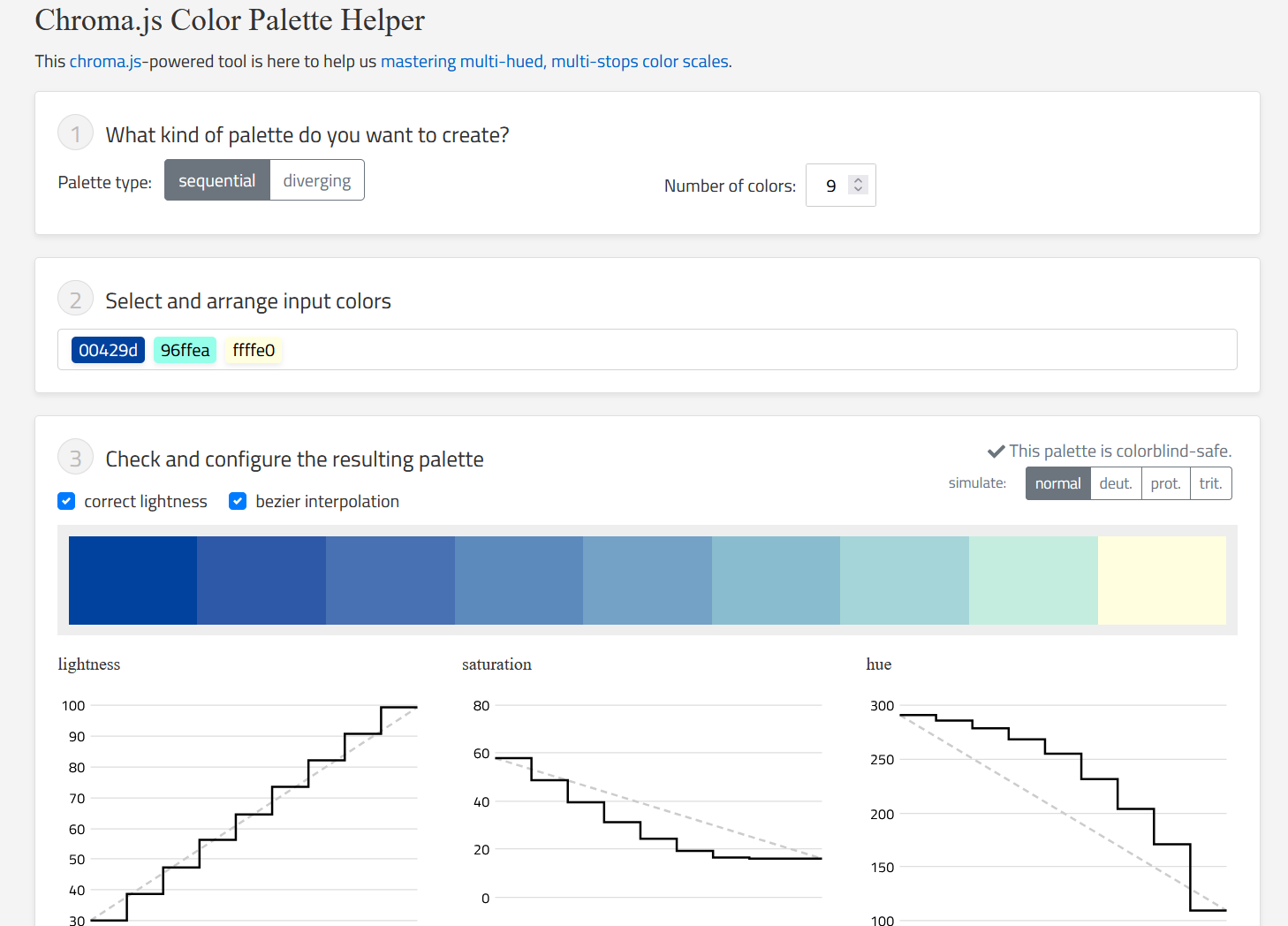
Distinguishable colours
- Interpolate between “anchor colours”
- Check for “friendliness”
- Tweak colours as required to make them work
Testing with real graphs
projects.susielu.com/viz-palette
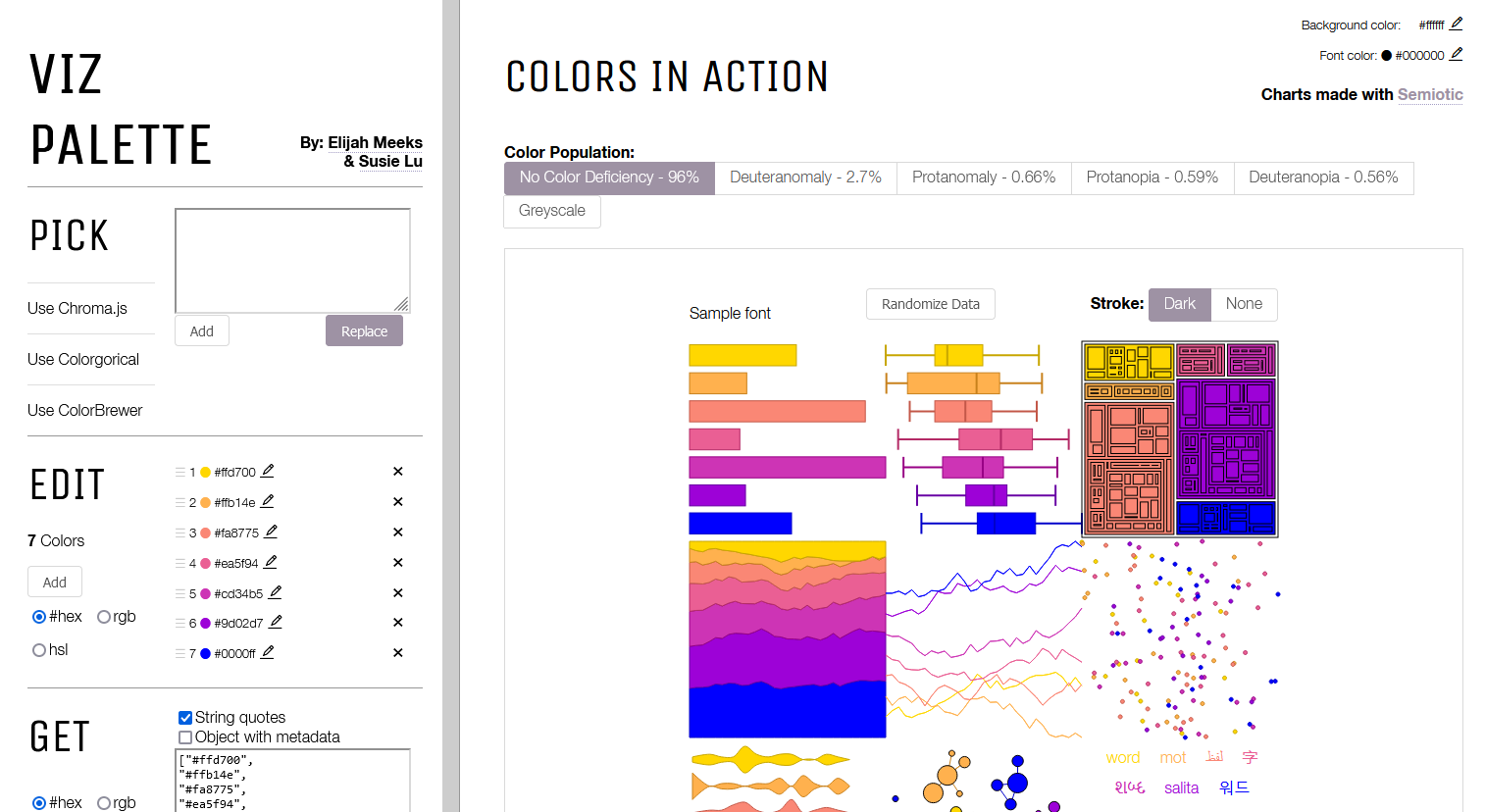
Testing with (your!) real graphs
daltonlens.org/colorblindness-simulator
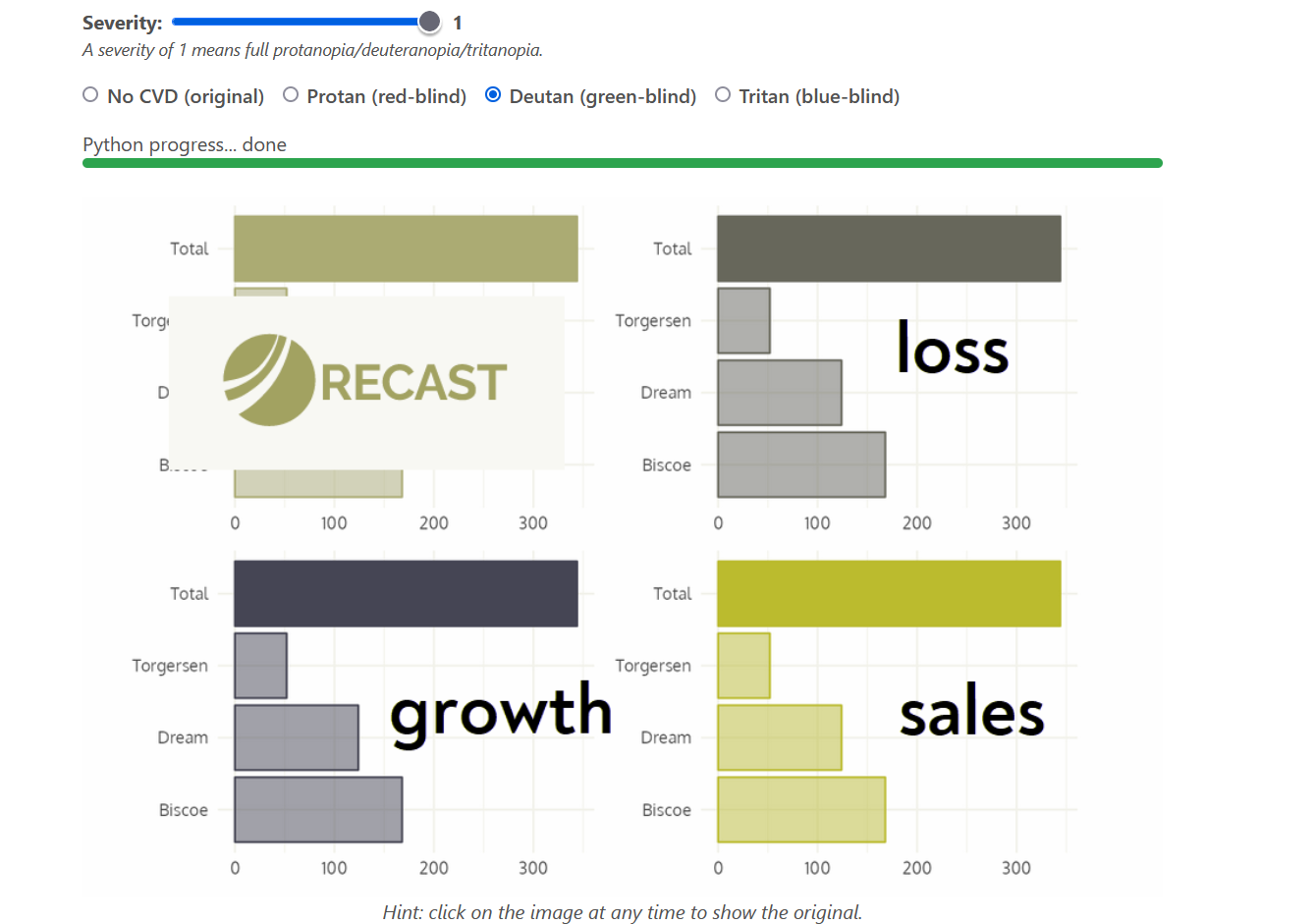
Text and colour contrast

Text and colour contrast

Text and colour contrast
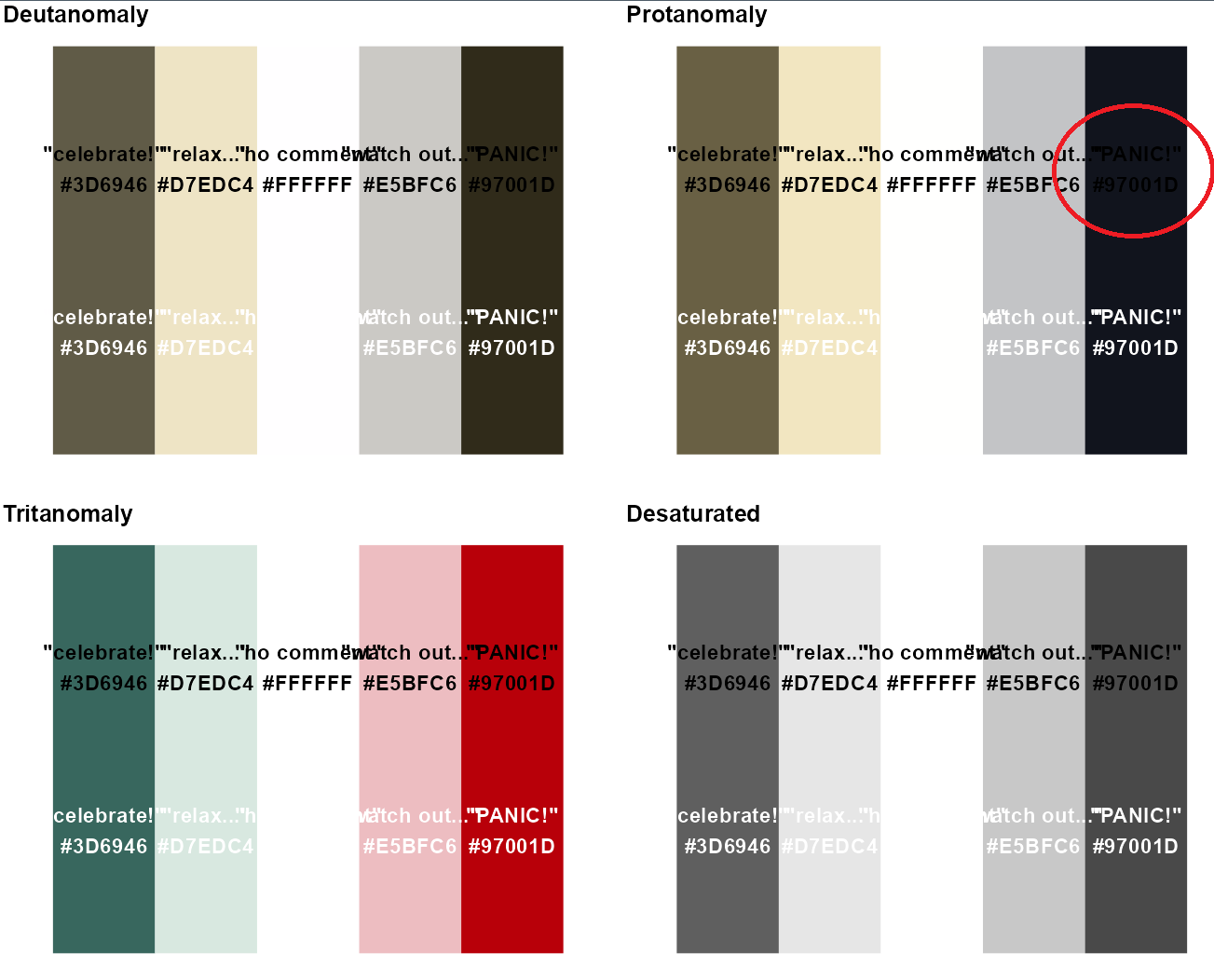
Text and colour contrast
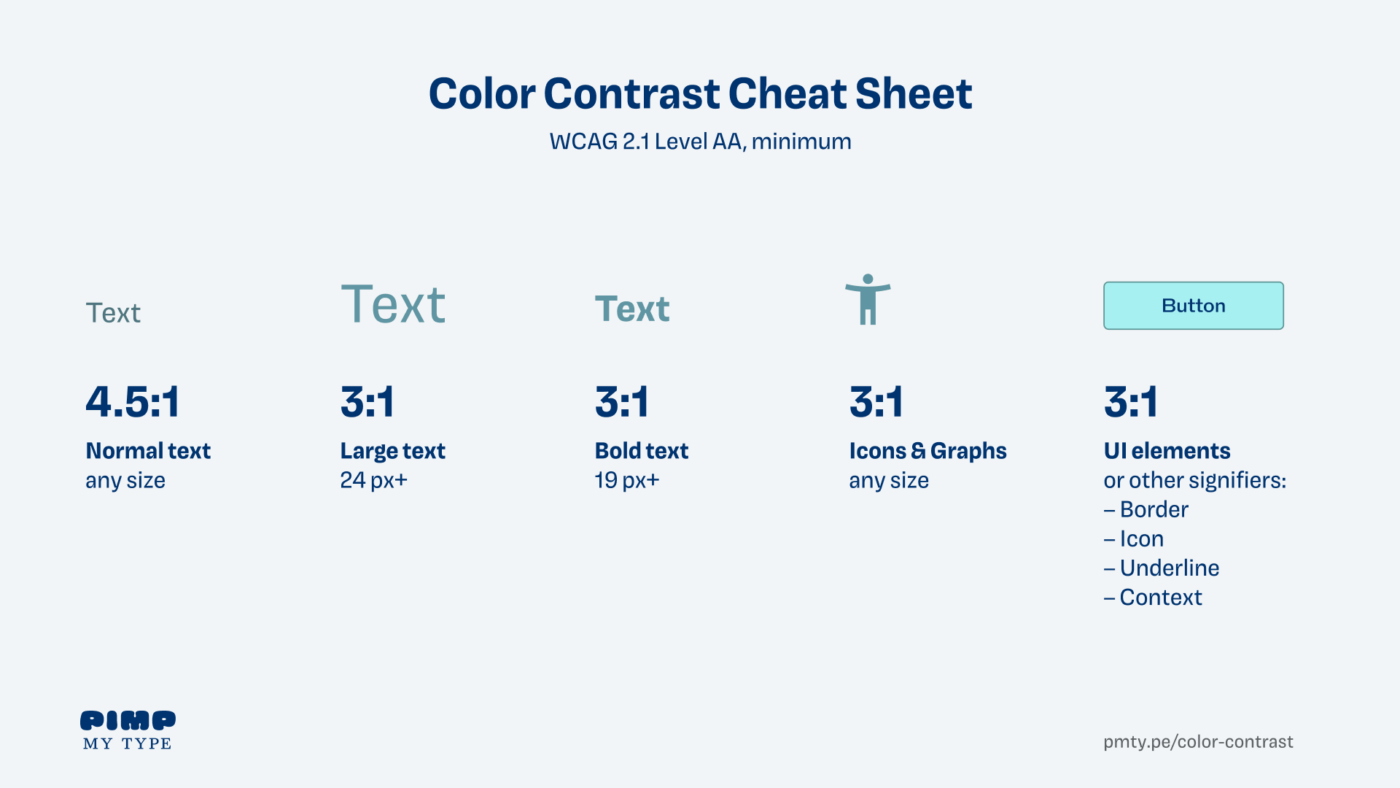
Source: pimpmytype.com/color-contrast/
Text and colour contrasts
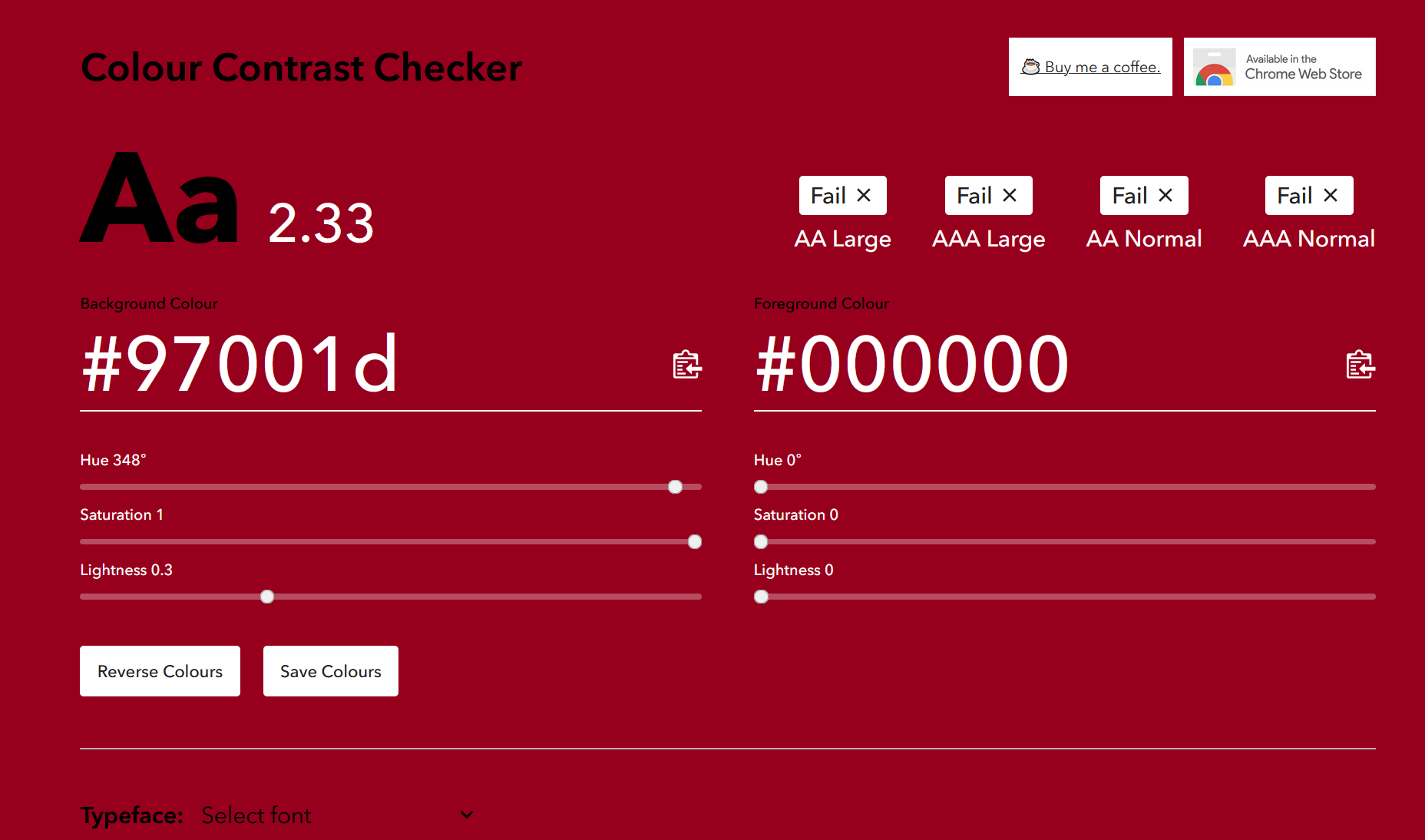
Over to you
- Check the colours you have come up with
- Viz palette checker
- What colour text will you use with them?
- Color contrast checker
- Try implementing these in your own plot and uploading a screenshot to the colourblindness simulator or using
colorblindr::cvd_grid()- Any surprises?
- How can you address them?
Links to resources: cararthompson.com/talks - first one
You have 5 minutes! 📊 🎨
05:00
Compelling and memorable visualisations
#1 - Use colour and orientation purposefully
#2 - Add text hierarchy
#3 - Reduce unnecessary eye movement
#4 - Highlight important patterns
#2 - Add text hierarchy
Find out more: https://www.interaction-design.org/
#2 - Add text hierarchy
Time to start playing with theme()!
basic_plot <- ToothGrowth %>%
mutate(supplement = case_when(supp == "OJ" ~ "Orange Juice", supp == "VC" ~ "Vitamin C", TRUE ~ as.character(supp))) %>%
group_by(supplement, dose) %>%
summarise(mean_length = mean(len)) %>%
mutate(categorical_dose = factor(dose)) %>%
ggplot(aes(x = categorical_dose, y = mean_length, fill = supplement)) +
geom_bar(aes(alpha = dose), stat = "identity", colour = "#FFFFFF", size = 2) +
labs(x = "Dose",
y = "Mean length (mm)",
title = "In smaller doses, Orange Juice was associated with greater mean tooth growth,
compared to equivalent doses of Vitamin C",
subtitle = "With the highest dose, the mean recorded length was almost identical.") +
scale_fill_manual(values = vit_c_palette, limits = force) +
scale_alpha(range = c(0.4, 1)) +
scale_x_discrete(breaks = c("0.5", "1", "2"), labels = function(x) paste0(x, " mg/day")) +
coord_flip() +
facet_wrap(supplement ~ ., ncol = 1) +
theme_minimal(base_size = 15)
basic_plot#2 - Add text hierarchy
Time to start playing with theme()!
#2 - Add text hierarchy
Time to start playing with theme()!
#2 - Add text hierarchy
Time to start playing with theme()!
#2 - Add text hierarchy
Time to start playing with theme()!
#2 - Add text hierarchy
Move away from the default fonts
#2 - Add text hierarchy
Move away from the default fonts
basic_plot +
theme(legend.position = "none",
text = element_text(colour = vit_c_palette["light_text"],
family = "Cabin"),
plot.title = element_text(colour = vit_c_palette["dark_text"],
size = rel(1.5),
face = "bold",
family = "Enriqueta"),
strip.text = element_text(family = "Enriqueta",
colour = vit_c_palette["light_text"],
size = rel(1.1), face = "bold"),
axis.text = element_text(colour = vit_c_palette["light_text"]))#2 - Add text hierarchy
Choosing fonts can be tricky!
- Brand guidelines
- Datawrapper guidance - avoid fonts that are too wide/narrow!
- Websites + inspector tool
- Oliver Schöndorfer’s exploration of the Font Matrix
Find out more: pimpmytype.com/font-matrix/
#2 - Add text hierarchy
Getting custom fonts to work can be frustrating!
Install fonts locally, restart R Studio + 📦
{systemfonts}({ragg}+{textshaping}) + Set graphics device to “AGG” + 🤞
#2 - Add text hierarchy
- set of fonts + set of colours + rules…
A Dataviz Design System: A simple set of rules to follow, to effortlessly make your visualisations look on brand, every time you go to create a new plot.
- Accessibility
- Meaningful colours within your context
- “Visual identity”
- Implement as a R package
- Wednesday 11th October 2023 @ 14.05
Find out more: cararthompson.com/talks/rmedicine2023-dataviz-design-system/
#2 - Add text hierarchy
Give everything some space to breathe
basic_plot +
theme(legend.position = "none",
text = element_text(colour = vit_c_palette["light_text"],
family = "Cabin"),
plot.title = element_text(colour = vit_c_palette["dark_text"],
size = rel(1.5),
face = "bold",
family = "Enriqueta"),
strip.text = element_text(family = "Enriqueta",
colour = vit_c_palette["light_text"],
size = rel(1.1), face = "bold"),
axis.text = element_text(colour = vit_c_palette["light_text"]))#2 - Add text hierarchy
Give everything some space to breathe
basic_plot +
theme(legend.position = "none",
text = element_text(colour = vit_c_palette["light_text"],
family = "Cabin"),
plot.title = element_text(colour = vit_c_palette["dark_text"],
size = rel(1.5),
face = "bold",
family = "Enriqueta",
lineheight = 1.3,
margin = margin(0.5, 0, 1, 0, "lines")),
plot.subtitle = element_text(size = rel(1.1), lineheight = 1.3,
margin = margin(0, 0, 1, 0, "lines")),
strip.text = element_text(family = "Enriqueta",
colour = vit_c_palette["light_text"],
size = rel(1.1), face = "bold",
margin = margin(2, 0, 0.5, 0, "lines")),
axis.text = element_text(colour = vit_c_palette["light_text"]))#2 - Add text hierarchy
Remove unnecessary text
basic_plot +
theme(legend.position = "none",
text = element_text(colour = vit_c_palette["light_text"],
family = "Cabin"),
axis.title.y = element_blank(),
plot.title = element_text(colour = vit_c_palette["dark_text"],
size = rel(1.5),
face = "bold",
family = "Enriqueta",
lineheight = 1.3,
margin = margin(0.5, 0, 1, 0, "lines")),
plot.subtitle = element_text(size = rel(1.1), lineheight = 1.3,
margin = margin(0, 0, 1, 0, "lines")),
strip.text = element_text(family = "Enriqueta",
colour = vit_c_palette["light_text"],
size = rel(1.1), face = "bold",
margin = margin(2, 0, 0.5, 0, "lines")),
axis.text = element_text(colour = vit_c_palette["light_text"]))#2 - Add text hierarchy
Watch out for that title!
basic_plot +
labs(title = "In smaller doses, Orange Juice was associated with greater mean tooth growth,
compared to equivalent doses of Vitamin C") +
theme(legend.position = "none",
text = element_text(colour = vit_c_palette["light_text"],
family = "Cabin"),
axis.title.y = element_blank(),
plot.title = element_text(colour = vit_c_palette["dark_text"],
size = 36,
face = "bold",
family = "Enriqueta",
lineheight = 1.3,
margin = margin(0.5, 0, 1, 0, "lines")),
plot.subtitle = element_text(size = rel(1.1), lineheight = 1.3,
margin = margin(0, 0, 1, 0, "lines")),
strip.text = element_text(family = "Enriqueta",
colour = vit_c_palette["light_text"],
size = rel(1.1), face = "bold",
margin = margin(2, 0, 0.5, 0, "lines")),
axis.text = element_text(colour = vit_c_palette["light_text"]))#2 - Add text hierarchy
Watch out for that title!
basic_plot +
labs(title = "In smaller doses, Orange Juice was associated with greater mean tooth growth, compared to equivalent doses of Vitamin C") +
theme(legend.position = "none",
text = element_text(colour = vit_c_palette["light_text"],
family = "Cabin"),
axis.title.y = element_blank(),
plot.title = element_text(colour = vit_c_palette["dark_text"],
size = rel(1.5),
face = "bold",
family = "Enriqueta",
lineheight = 1.3,
margin = margin(0.5, 0, 1, 0, "lines")),
plot.subtitle = element_text(size = rel(1.1), lineheight = 1.3,
margin = margin(0, 0, 1, 0, "lines")),
strip.text = element_text(family = "Enriqueta",
colour = vit_c_palette["light_text"],
size = rel(1.1), face = "bold",
margin = margin(2, 0, 0.5, 0, "lines")),
axis.text = element_text(colour = vit_c_palette["light_text"]))#2 - Add text hierarchy
I ❤️ 📦 {ggtext}
basic_plot +
labs(title = "In smaller doses, Orange Juice was associated with greater mean tooth growth, compared to equivalent doses of Vitamin C") +
theme(legend.position = "none",
text = element_text(colour = vit_c_palette["light_text"],
family = "Cabin"),
axis.title.y = element_blank(),
plot.title = ggtext::element_textbox_simple(
colour = vit_c_palette["dark_text"],
size = rel(1.5),
face = "bold",
family = "Enriqueta",
lineheight = 1.3,
margin = margin(0.5, 0, 1, 0, "lines")),
plot.subtitle = ggtext::element_textbox_simple(
size = rel(1.1),
lineheight = 1.3,
margin = margin(0, 0, 1, 0, "lines")),
strip.text = element_text(family = "Enriqueta",
colour = vit_c_palette["light_text"],
size = rel(1.1), face = "bold",
margin = margin(2, 0, 0.5, 0, "lines")),
axis.text = element_text(colour = vit_c_palette["light_text"]))#2 - Add text hierarchy + colour!
Hello, HTML + CSS!
We can make text <span style='color:green'>green</span> and also <span style='color:green; font-size:60pt'>really big</span>! 🤯
We can make text green and also really big! 🤯
#2 - Add text hierarchy + colour!
I ❤️ 📦 {ggtext}
basic_plot +
labs(title =
paste0("In smaller doses, **<span style='color:",
vit_c_palette["Orange Juice"], "'>Orange Juice</span>**
was associated with greater mean tooth growth,
compared to equivalent doses of **<span style='color:",
vit_c_palette["Vitamin C"], "'>Vitamin C</span>**")
) +
theme(legend.position = "none",
text = element_text(colour = vit_c_palette["light_text"],
family = "Cabin"),
axis.title.y = element_blank(),
plot.title = ggtext::element_textbox_simple(colour = vit_c_palette["dark_text"],
size = rel(1.5),
face = "bold",
family = "Enriqueta",
lineheight = 1.3,
margin = margin(0.5, 0, 1, 0, "lines")),
plot.subtitle = ggtext::element_textbox_simple(family = "Cabin", size = rel(1.1), lineheight = 1.3,
margin = margin(0, 0, 1, 0, "lines")),
strip.text = element_text(family = "Enriqueta",
colour = vit_c_palette["light_text"],
size = rel(1.1), face = "bold",
margin = margin(2, 0, 0.5, 0, "lines")),
axis.text = element_text(colour = vit_c_palette["light_text"]))#2 - Add text hierarchy + colour!
Wait, that yellow… #fab909
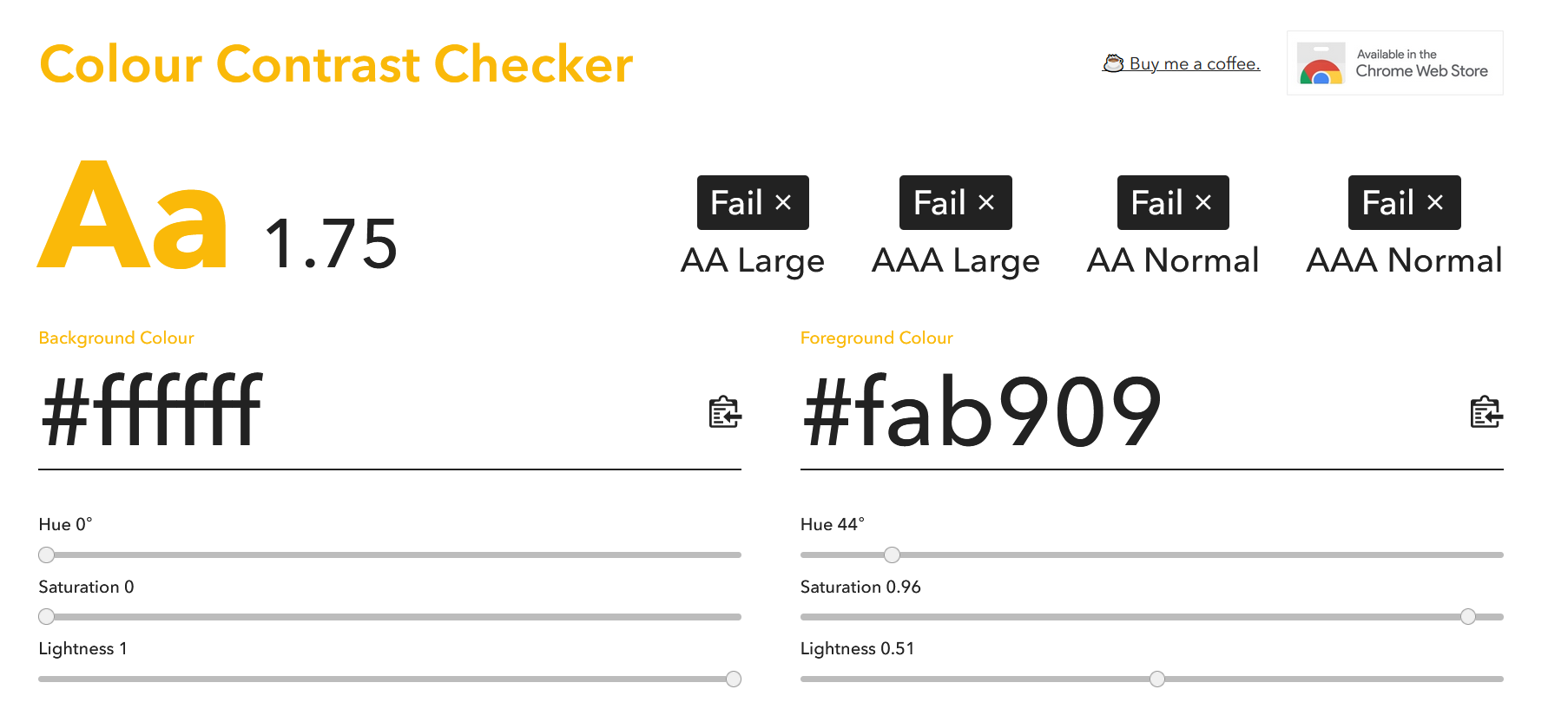
#2 - Add text hierarchy + colour!
Wait, that yellow…
#2 - Add text hierarchy + colour!
basic_plot +
labs(title =
paste0("In smaller doses, **<span style='color:",
vit_c_palette["Orange Juice text"], "'>Orange Juice</span>**
was associated with greater mean tooth growth,
compared to equivalent doses of **<span style='color:",
vit_c_palette["Vitamin C"], "'>Vitamin C</span>**")
) +
theme(legend.position = "none",
text = element_text(colour = vit_c_palette["light_text"],
family = "Cabin"),
axis.title.y = element_blank(),
plot.title = ggtext::element_textbox_simple(colour = vit_c_palette["dark_text"],
size = rel(1.5),
face = "bold",
family = "Enriqueta",
lineheight = 1.3,
margin = margin(0.5, 0, 1, 0, "lines")),
plot.subtitle = ggtext::element_textbox_simple(family = "Cabin", size = rel(1.1), lineheight = 1.3,
margin = margin(0, 0, 1, 0, "lines")),
strip.text = element_text(family = "Enriqueta",
colour = vit_c_palette["light_text"],
size = rel(1.1), face = "bold",
margin = margin(2, 0, 0.5, 0, "lines")),
axis.text = element_text(colour = vit_c_palette["light_text"]))#2 - Add text hierarchy + colour!
See for yourselves!
Quiz time!

… but do we?
Do we need a legend?

Source: https://learn.microsoft.com/en-us/power-bi/visuals/service-reports-show-data
- ?
Do we need a legend?

- No Colour = Y axis labels, no additional information
Source: https://learn.microsoft.com/en-us/power-bi/visuals/service-reports-show-data
Do we need a legend?

- ?
Source: https://www.canva.com/p/templates/EAFYZYCiOWE-blue-modern-line-bar-chart-graph/
Do we need a legend?

- Yes: No other way of telling; also, nicely in the right order
Source: https://www.canva.com/p/templates/EAFYZYCiOWE-blue-modern-line-bar-chart-graph/
Do we need a legend?
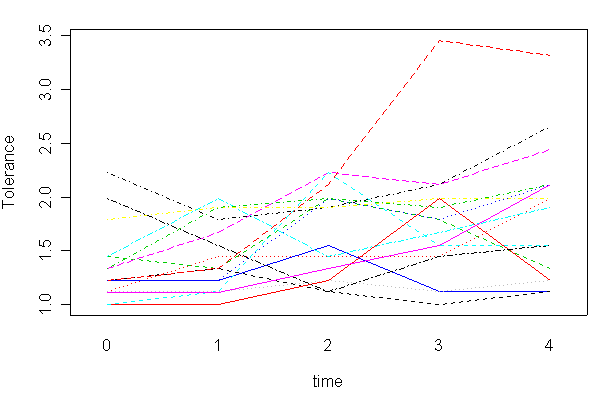
- ?
Do we need a legend?

- Yes - or line-end annotations… or a different plot type? (👀 small multiples)
Do we need a legend?
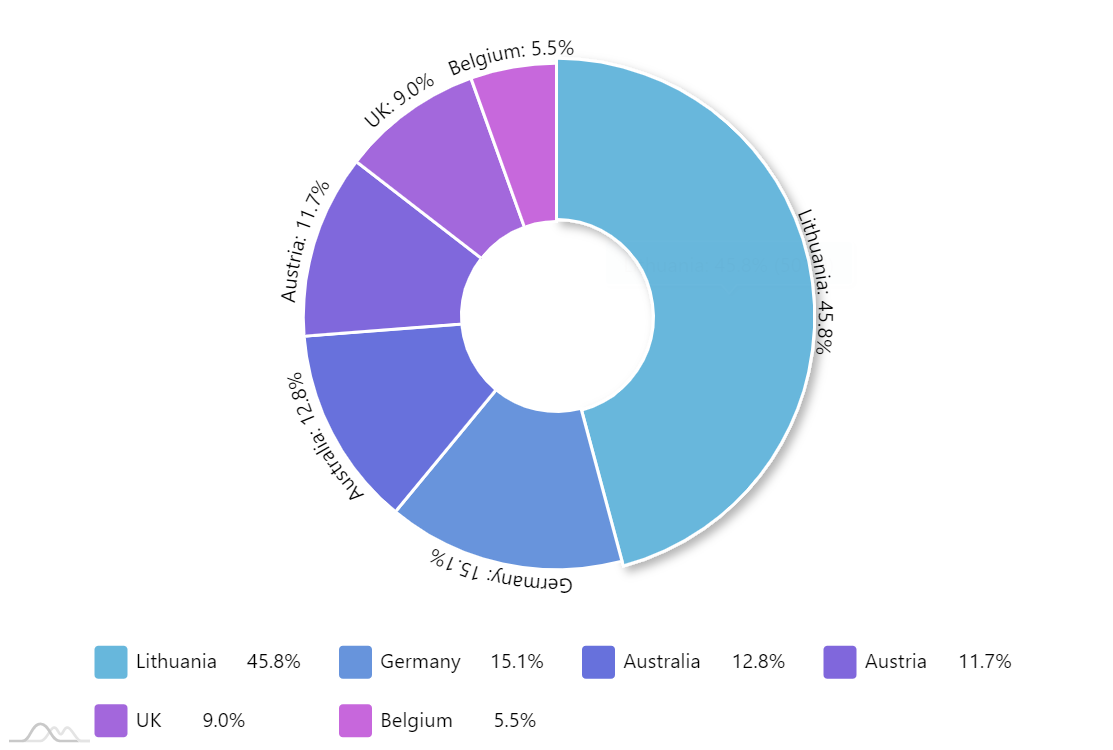
- ?
Do we need a legend?

- No - the annotations say it all (and are much clearer)
Do we need a legend?

- ?
Do we need a legend?

- No - But legend adds more information… Consider turning the legend into a table
Does it need a legend?

- ?
Does it need a legend?

- Yes, but I’d rethink it
Over to you!
- Look at all your text: do you need it?
- See what fonts are available on your device -
systemfonts::systemfonts() |> View()- If you want to, install a new one!
- Apply one to the title, and one to the rest of the text using
theme() - Create some text colour variants using
monochromeR::generate_palette() - Apply those colours to the title and the other text elements
- Play around with (relative) text sizes
- Give me a shout if you get stuck!
You have 10 minutes! 📊 🎨 ☕
10:00
Packaging up
- Package development is a whole other workshop (but it’s easier than you think!)
- 📦
{usethis}
- 📦
- Any function or object you create can be added to a package
Find out more: Shannon Pileggi - Your first R package in 1 hour
Packaging up
Packaging up
theme_guineapigs <- function(base_text_size = 15,
palette = vit_c_palette) {
theme_minimal(base_size = base_text_size) +
theme(legend.position = "none",
text = element_text(colour = palette["light_text"],
family = "Cabin"),
axis.title.y = element_blank(),
plot.title = ggtext::element_textbox_simple(colour = palette["dark_text"],
size = rel(1.5),
face = "bold",
family = "Enriqueta",
lineheight = 1.3,
margin = margin(0.5, 0, 1, 0, "lines")),
plot.subtitle = ggtext::element_textbox_simple(family = "Cabin", size = rel(1.1), lineheight = 1.3,
margin = margin(0, 0, 1, 0, "lines")),
strip.text = element_text(family = "Enriqueta",
colour = palette["light_text"],
size = rel(1.1), face = "bold",
margin = margin(2, 0, 0.5, 0, "lines")),
axis.text = element_text(colour = palette["light_text"]),
plot.margin = margin(rep(base_text_size, 4)),
plot.title.position = "plot")
}Packaging up
theme_guineapigs <- function(base_text_size = 15,
palette = vit_c_palette) {
theme_minimal(base_size = base_text_size) +
theme(legend.position = "none",
text = element_text(colour = palette["light_text"],
family = "Cabin"),
axis.title.y = element_blank(),
plot.title = ggtext::element_textbox_simple(colour = palette["dark_text"],
size = rel(1.5),
face = "bold",
family = "Enriqueta",
lineheight = 1.3,
margin = margin(0.5, 0, 1, 0, "lines")),
plot.subtitle = ggtext::element_textbox_simple(family = "Cabin", size = rel(1.1), lineheight = 1.3,
margin = margin(0, 0, 1, 0, "lines")),
strip.text = element_text(family = "Enriqueta",
colour = palette["light_text"],
size = rel(1.1), face = "bold",
margin = margin(2, 0, 0.5, 0, "lines")),
axis.text = element_text(colour = palette["light_text"]))
}Packaging up
Packaging up
Level up your plots
#1 - Use colour purposefully
#2 - Add text hierarchy
#3 - Reduce unnecessary eye movement
#4 - Highlight important patterns
#3 - Reduce unnecessary eye movement
We’ve made it easy to see what’s what. Now, let’s make it even easier to compare values.
#3 - Reduce unnecessary eye movement
We’ve made it easy to see what’s what. Now, let’s make it even easier to compare values.
#3 - Reduce unnecessary eye movement
We’ve made it easy to see what’s what. Now, let’s make it even easier to compare values.
#3 - Reduce unnecessary eye movement
Time to add some text boxes!
#3 - Reduce unnecessary eye movement
Time to add some text boxes!
Find out more: Alignment Cheatsheet
#3 - Reduce unnecessary eye movement
Time to add some text boxes!
#3 - Reduce unnecessary eye movement
Time to add some text boxes!
#3 - Reduce unnecessary eye movement
Now for the fun stuff…
themed_plot +
scale_y_continuous(expand = c(0, 0.5)) +
theme(strip.text = element_text(hjust = 0.03)) +
ggtext::geom_textbox(aes(
label = mean_length,
hjust = case_when(mean_length < 15 ~ 0,
TRUE ~ 1),
halign = case_when(mean_length < 15 ~ 0,
TRUE ~ 1)),
size = 6,
fill = NA,
box.colour = NA,
family = "Cabin",
fontface = "bold")#3 - Reduce unnecessary eye movement
Now for the fun stuff…
themed_plot +
scale_y_continuous(expand = c(0, 0.5)) +
theme(strip.text = element_text(hjust = 0.03)) +
ggtext::geom_textbox(aes(
label = mean_length,
hjust = case_when(mean_length < 15 ~ 0,
TRUE ~ 1),
halign = case_when(mean_length < 15 ~ 0,
TRUE ~ 1),
colour = case_when(mean_length > 15 ~ "#FFFFFF",
TRUE ~ vit_c_palette[supplement])),
size = 6,
fill = NA,
box.colour = NA,
family = "Cabin",
fontface = "bold")#3 - Reduce unnecessary eye movement
??????
themed_plot +
scale_y_continuous(expand = c(0, 0.5)) +
theme(strip.text = element_text(hjust = 0.03)) +
ggtext::geom_textbox(aes(
label = mean_length,
hjust = case_when(mean_length < 15 ~ 0,
TRUE ~ 1),
halign = case_when(mean_length < 15 ~ 0,
TRUE ~ 1),
colour = case_when(mean_length > 15 ~ "#FFFFFF",
TRUE ~ vit_c_palette[supplement])),
size = 6,
fill = NA,
box.colour = NA,
family = "Cabin",
fontface = "bold")#3 - Reduce unnecessary eye movement
scale_colour_identity() required!
themed_plot +
scale_y_continuous(expand = c(0, 0.5)) +
theme(strip.text = element_text(hjust = 0.03)) +
scale_colour_identity() +
ggtext::geom_textbox(aes(
label = mean_length,
hjust = case_when(mean_length < 15 ~ 0,
TRUE ~ 1),
halign = case_when(mean_length < 15 ~ 0,
TRUE ~ 1),
colour = case_when(mean_length > 15 ~ "#FFFFFF",
TRUE ~ vit_c_palette[supplement])),
size = 6,
fill = NA,
box.colour = NA,
family = "Cabin",
fontface = "bold")#3 - Reduce unnecessary eye movement
We might as well add a bit of extra info (with text hierarchy!) to our labels…
themed_plot +
scale_y_continuous(expand = c(0, 0.5)) +
theme(strip.text = element_text(hjust = 0.03)) +
scale_colour_identity() +
ggtext::geom_textbox(aes(
label = paste0("<span style=font-size:12pt>",
dose, "mg/day</span><br>",
mean_length, "mm"),
hjust = case_when(mean_length < 15 ~ 0,
TRUE ~ 1),
halign = case_when(mean_length < 15 ~ 0,
TRUE ~ 1),
colour = case_when(mean_length > 15 ~ "#FFFFFF",
TRUE ~ vit_c_palette[supplement])),
size = 6,
fill = NA,
box.colour = NA,
family = "Cabin",
fontface = "bold")#3 - Reduce unnecessary eye movement
We might as well add a bit of extra info (with text hierarchy!) to our labels…
themed_plot +
scale_y_continuous(expand = c(0, 0.5)) +
theme(strip.text = element_text(hjust = 0.03)) +
scale_colour_identity() +
ggtext::geom_textbox(aes(
label = paste0("<span style=font-size:12pt>",
dose, "mg/day</span><br>",
janitor::round_half_up(mean_length),
"mm"),
hjust = case_when(mean_length < 15 ~ 0,
TRUE ~ 1),
halign = case_when(mean_length < 15 ~ 0,
TRUE ~ 1),
colour = case_when(mean_length > 15 ~ "#FFFFFF",
TRUE ~ vit_c_palette[supplement])),
size = 6,
fill = NA,
box.colour = NA,
family = "Cabin",
fontface = "bold")Wait, but why?
Wait, but why?
new_data %>% guinea_pig_plot()
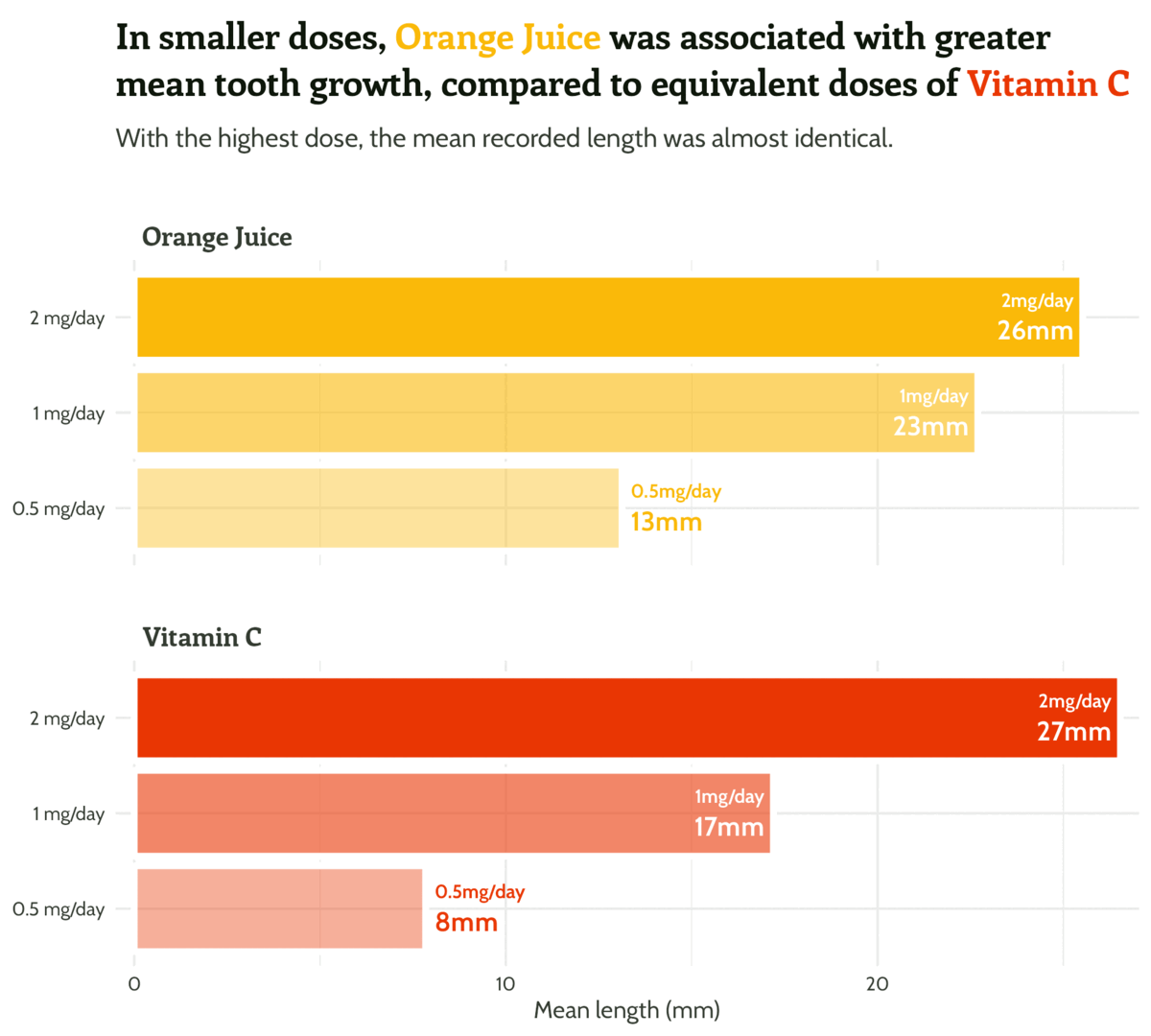
#3 - Reduce unnecessary eye movement
Let’s fix that alignment…
themed_plot +
scale_y_continuous(expand = c(0, 0.5)) +
scale_colour_identity() +
ggtext::geom_textbox(aes(
label = paste0("<span style=font-size:12pt>",
dose, "mg/day</span><br>",
janitor::round_half_up(mean_length),
"mm"),
hjust = case_when(mean_length < 15 ~ 0,
TRUE ~ 1),
halign = case_when(mean_length < 15 ~ 0,
TRUE ~ 1),
colour = case_when(mean_length > 15 ~ "#FFFFFF",
TRUE ~ vit_c_palette[supplement])),
size = 6,
fill = NA,
box.colour = NA,
family = "Cabin",
fontface = "bold") +
theme(strip.text = element_text(hjust = 0.03),
plot.title.position = "plot")#3 - Reduce unnecessary eye movement
And add some breathing space around the plot…
themed_plot +
scale_y_continuous(expand = c(0, 0.5)) +
scale_colour_identity() +
ggtext::geom_textbox(aes(
label = paste0("<span style=font-size:12pt>",
dose, "mg/day</span><br>",
janitor::round_half_up(mean_length),
"mm"),
hjust = case_when(mean_length < 15 ~ 0,
TRUE ~ 1),
halign = case_when(mean_length < 15 ~ 0,
TRUE ~ 1),
colour = case_when(mean_length > 15 ~ "#FFFFFF",
TRUE ~ vit_c_palette[supplement])),
size = 6,
fill = NA,
box.colour = NA,
family = "Cabin",
fontface = "bold") +
theme(strip.text = element_text(hjust = 0.03),
plot.title.position = "plot",
plot.margin = margin(rep(15, 4)))#3 - Reduce unnecessary eye movement
Easier than you think and makes a big difference! 🦸
Over to you!
- Add a textbox (or several!) using
ggtext::geom_textbox() - Add in some styling (text hierarchy / colour) and conditional alignments
- See what happens when you apply your plot code to random subsets of your data
You have 10 minutes! 📊 🎨 ☕
10:00
Level up your plots
#1 - Use colour purposefully
#2 - Add text hierarchy
#3 - Reduce unnecessary eye movement
#4 - Highlight important patterns
#4 - Highlight important patterns
How did those penguins get on anyway…?
- Means, trends, key data points
Find out more: cararthompson.com/talks/hdsi_rug/
#4 - Highlight important patterns | means
Consider text boxes instead of a legend…
# Create a new tibble
penguin_summaries <- palmerpenguins::penguins %>%
group_by(species) %>%
summarise(bill_depth_mm = mean(bill_depth_mm, na.rm = TRUE),
bill_length_mm = mean(bill_length_mm, na.rm = TRUE)) %>%
mutate(commentary = case_when(
species == "Adelie" ~
"The Adelie penguins tried varying the amount of banana in the mix.
Turns out, even a hint of green banana is detrimental to yumminess!",
species == "Gentoo" ~
"Over-ripe bananas and typically shorter baking times.",
TRUE ~ "Ripe bananas and slightly longer cooking times."))#4 - Highlight important patterns | means
Consider text boxes instead of a legend…
#4 - Highlight important patterns | means
Consider text boxes instead of a legend…
#4 - Highlight important patterns | means
Consider text boxes instead of a legend…
#4 - Highlight important patterns | trends
I ❤️ 📦 {geomtextpath}
#4 - Highlight important patterns | trends
I ❤️ 📦 {geomtextpath}
#4 - Highlight important patterns | trends
I ❤️ 📦 {geomtextpath}
#4 - Highlight important patterns | trends
I ❤️ 📦 {geomtextpath}
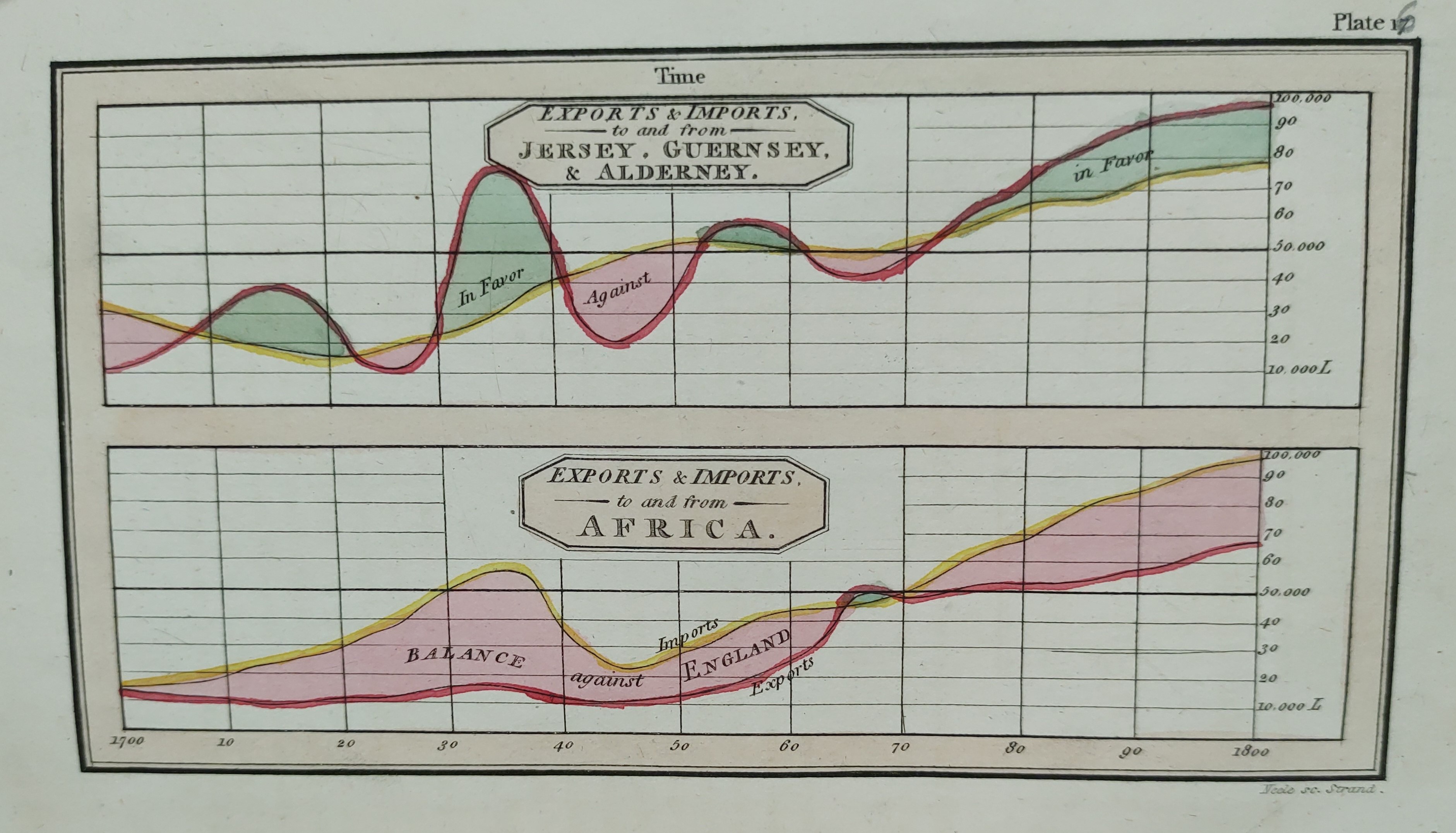
#4 - Highlight important patterns | trends
I ❤️ 📦 {geomtextpath}
#4 - Highlight important patterns | trends
I ❤️ 📦 {geomtextpath}

#4 - Highlight important patterns | points
What about individual penguins?
penguin_highlights <- palmerpenguins::penguins_raw %>%
# Housekeeping
janitor::clean_names() %>%
rename(bill_depth_mm = culmen_depth_mm,
bill_length_mm = culmen_length_mm) %>%
# Find star baker, runner up and lowest score
filter(bill_length_mm %in% c(max(bill_length_mm, na.rm = TRUE),
sort(bill_length_mm, decreasing = TRUE)[2],
min(bill_length_mm, na.rm = TRUE))) #4 - Highlight important patterns | points
First, a bit of text manipulation!
penguin_highlights <- palmerpenguins::penguins_raw %>%
janitor::clean_names() %>%
rename(bill_depth_mm = culmen_depth_mm,
bill_length_mm = culmen_length_mm) %>%
filter(bill_length_mm %in% c(max(bill_length_mm, na.rm = TRUE),
sort(bill_length_mm, decreasing = TRUE)[2],
min(bill_length_mm, na.rm = TRUE))) %>%
# More housekeeping
mutate(species = gsub("(.) (.*)", "\\1", species))#4 - Highlight important patterns | points
First, a bit of text manipulation!
penguin_highlights <- palmerpenguins::penguins_raw %>%
janitor::clean_names() %>%
rename(bill_depth_mm = culmen_depth_mm,
bill_length_mm = culmen_length_mm) %>%
filter(bill_length_mm %in% c(max(bill_length_mm, na.rm = TRUE),
sort(bill_length_mm, decreasing = TRUE)[2],
min(bill_length_mm, na.rm = TRUE))) %>%
mutate(species = gsub("(.) (.*)", "\\1", species),
# Add commentary!
commentary = case_when(
bill_length_mm == max(bill_length_mm) ~
paste0("Our star baker is **", individual_id,
"**, a ", species, " from ", island,
". Congratulations, ", individual_id, "!"),
bill_length_mm == sort(bill_length_mm, decreasing = TRUE)[2] ~
paste0("Our runner up is a ", species,
" from ", island, ": **", individual_id,
"**, proving that ripe and over-ripe bananas are both good options!"),
TRUE ~ paste0("**", individual_id,
"**, did not have a good baking day. The combination of short cooking time and green bananas probably didn't help!")))#4 - Highlight important patterns | points
First, a bit of text manipulation!
# A tibble: 3 x 4
individual_id species island commentary
<chr> <chr> <chr> <chr>
1 N81A1 Adelie Dream **N81A1**, did not have a good baking day. The~
2 N56A2 Gentoo Biscoe Our star baker is **N56A2**, a Gentoo from Bis~
3 N71A2 Chinstrap Dream Our runner up is a Chinstrap from Dream: **N71~#4 - Highlight important patterns | points
Next, let’s work out where we want our labels…

#4 - Highlight important patterns | points
… and add box coordinates and text alignment to our data
penguin_highlights <- palmerpenguins::penguins_raw %>%
janitor::clean_names() %>%
rename(bill_depth_mm = culmen_depth_mm,
bill_length_mm = culmen_length_mm) %>%
filter(bill_length_mm %in% c(max(bill_length_mm, na.rm = TRUE),
sort(bill_length_mm, decreasing = TRUE)[2],
min(bill_length_mm, na.rm = TRUE))) %>%
# more housekeeping!
arrange(bill_length_mm) %>%
mutate(species = gsub("(.) (.*)", "\\1", species),
commentary = case_when(
bill_length_mm == max(bill_length_mm) ~
paste0("Our star baker is **", individual_id, "**, a ", species, " from ", island, ". Congratulations, ", individual_id, "!"),
bill_length_mm == sort(bill_length_mm, decreasing = TRUE)[2] ~
paste0("Our runner up is a ", species, " from ", island, ": **", individual_id, "**, proving that ripe and over-ripe bananas are both good options!"),
TRUE ~ paste0("**", individual_id, "**, did not have a good baking day. The combination of short cooking time and green bananas probably didn't help!")),
# Add label and arrow coordinates
label_x = c(15, 18.15, 16.45),
label_y = c(34, 57, 59),
left_to_right = case_when(label_x < bill_depth_mm ~ 1,
TRUE ~ 0),
arrow_x_end = case_when(label_x < bill_depth_mm ~ bill_depth_mm - 0.1,
TRUE ~ bill_depth_mm + 0.1),
arrow_y_end = case_when(label_y < bill_length_mm ~ bill_length_mm - 0.1,
TRUE ~ bill_length_mm + 0.1))Find out more: cararthompson.com/posts/2021-09-02-alignment-cheat-sheet/
#4 - Highlight important patterns | points
Let’s add the annotations…
#4 - Highlight important patterns | points
Let’s add the annotations…
penguins_themed_plot +
ggtext::geom_textbox(data = penguin_summaries,
aes(label = paste0("**Team ", species, "**", "<br><span style = \"color:", banana_colours$light_text, "\">", commentary, "</span>")),
family = "DM Sans", size = 3.5, width = unit(9, "line"), alpha = 0.9, box.colour = NA) +
ggtext::geom_textbox(data = penguin_highlights,
aes(label = commentary,
x = label_x,
y = label_y,
hjust = left_to_right),
family = "DM Sans",
size = 3,
fill = NA,
box.colour = NA)#4 - Highlight important patterns | points
… using arrows and alignments to emphasise the story
penguins_themed_plot +
ggtext::geom_textbox(data = penguin_summaries,
aes(label = paste0("**Team ", species, "**", "<br><span style = \"color:", banana_colours$light_text, "\">", commentary, "</span>")),
family = "DM Sans", size = 3.5, width = unit(9, "line"), alpha = 0.9, box.colour = NA) +
ggtext::geom_textbox(data = penguin_highlights,
aes(label = commentary, x = label_x, y = label_y, hjust = left_to_right),
family = "DM Sans", size = 3, fill = NA, box.colour = NA) +
geom_curve(data = penguin_highlights,
aes(x = label_x, xend = arrow_x_end,
y = label_y, yend = arrow_y_end,
hjust = left_to_right),
arrow = arrow(length = unit(0.1, "cm")),
curvature = list(0.15),
alpha = 0.5)#4 - Highlight important patterns | points
… using arrows and alignments to emphasise the story
penguins_themed_plot +
ggtext::geom_textbox(data = penguin_summaries,
aes(label = paste0("**Team ", species, "**", "<br><span style = \"color:", banana_colours$light_text, "\">", commentary, "</span>")),
family = "DM Sans", size = 3.5, width = unit(9, "line"), alpha = 0.9, box.colour = NA) +
ggtext::geom_textbox(data = penguin_highlights,
aes(label = commentary, x = label_x, y = label_y, hjust = left_to_right,
halign = left_to_right),
family = "DM Sans", size = 3, fill = NA, box.colour = NA) +
geom_curve(data = penguin_highlights,
aes(x = label_x, xend = arrow_x_end,
y = label_y, yend = arrow_y_end),
arrow = arrow(length = unit(0.1, "cm")),
curvature = list(0.15),
alpha = 0.5)#4 - Highlight important patterns
Wait, but why again?
new_data %>% penguin_plot()
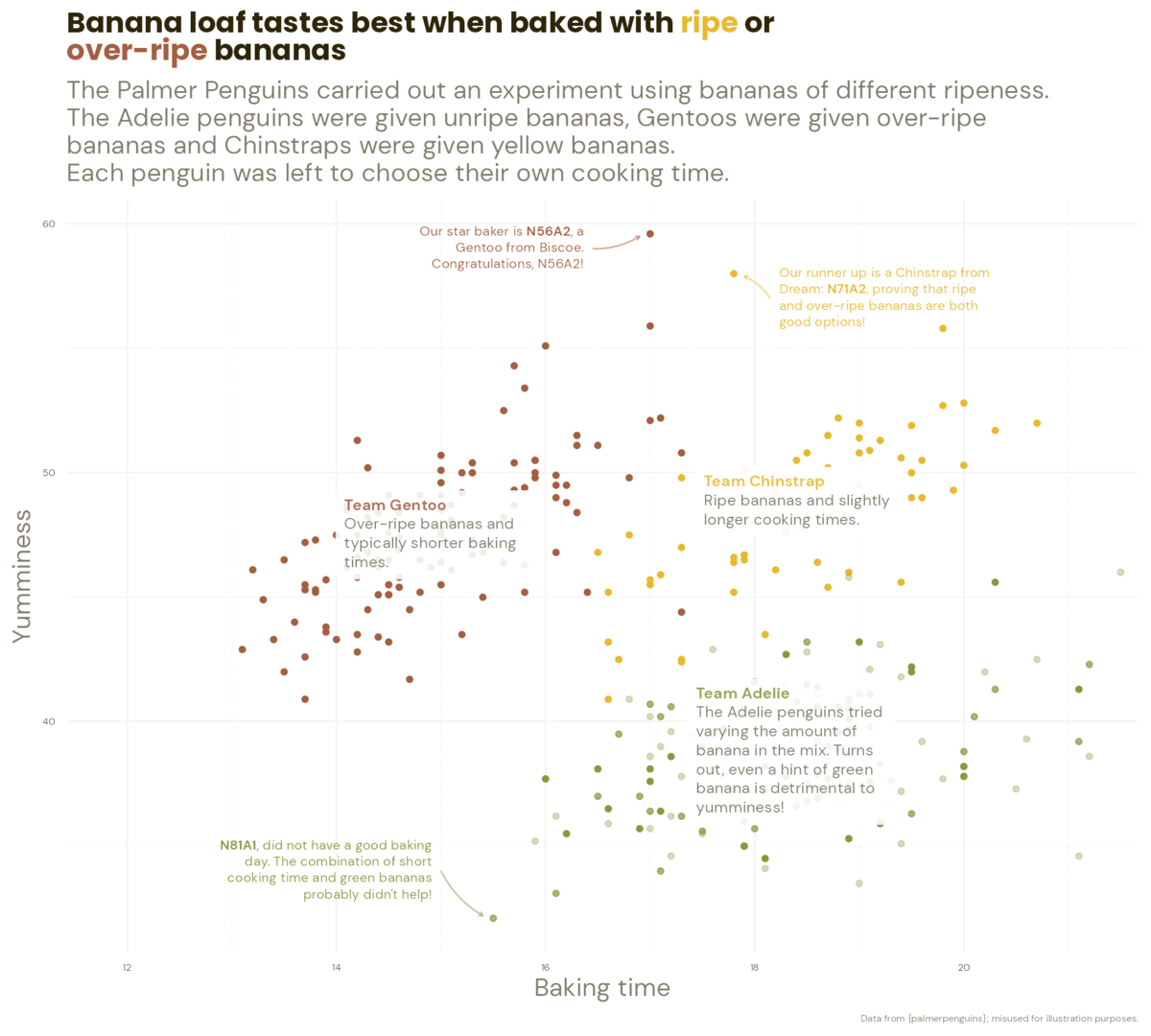
Wait, but why again?
new_data %>% time_comparisons_plot()
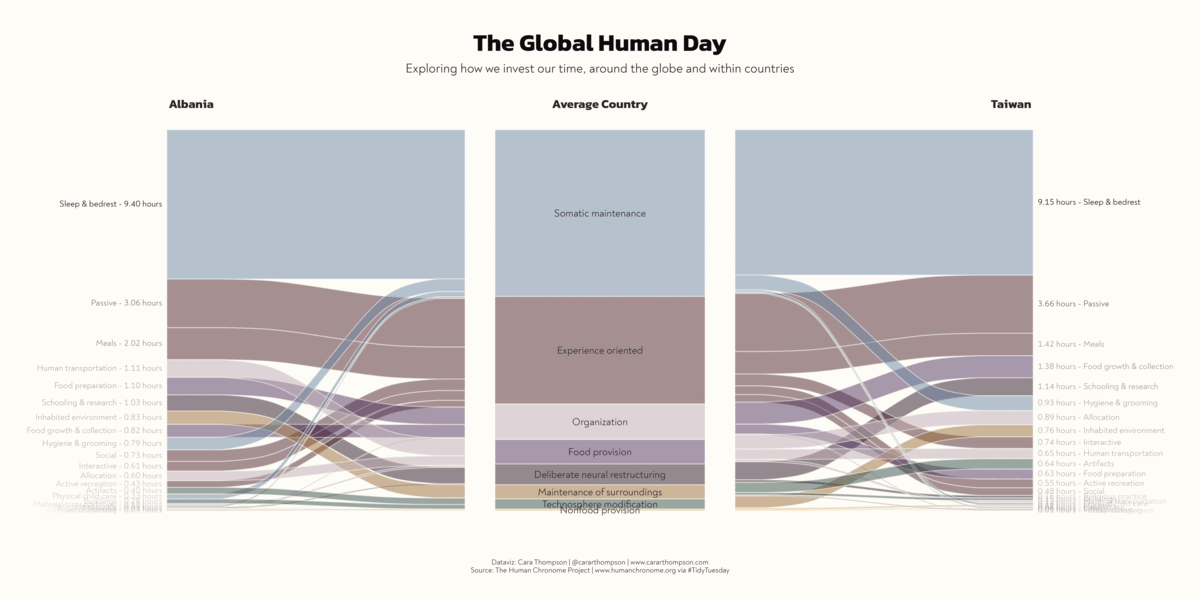
Level up your plots
The possibilities are endless!
Level up your plots
The possibilities are endless!
Level up your plots
The possibilities are endless!
Level up your plots
The possibilities are endless!
We made it!
Over to you!
hello@cararthompson.com
Tw/Li: cararthompson



